 Last additions - Finland フィンランド Last additions - Finland フィンランド |

Japan Day announcement in Helsingin Sanomat, Helsinki's leading newspaper.The announcement was one-fourth page. My two photos contrasted between the traditional and pop cultures.Apr 28, 2006
|
|
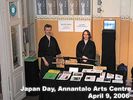
Budo boothApr 20, 2006
|
|
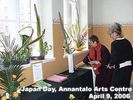
Completed flower arrangements.Apr 20, 2006
|
|
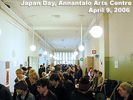
The entire building is jam-packed. This is the bazaar section.Apr 20, 2006
|
|
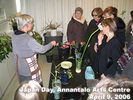
Flower arrangement lessonApr 18, 2006
|
|

Shodo calligraphy lessonApr 18, 2006
|
|

Kimono demonstrationApr 18, 2006
|
|
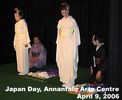
Kimono demonstration attracted the most attention. Many people could not enter the auditorium to see this.Apr 18, 2006
|
|

Kimono demonstrationApr 18, 2006
|
|
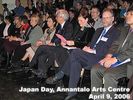
Japan Day Opening Ceremony with the Japanese ambassador to Finland and his wife sitting front and center.On Ambassador Kondo's left is Mrs. Johanna Lindstedt, the director of Annantalo, and next to her is Ronny Rönnqvist, the chairman of the Friends of Japanese Culture Society which was the co-organizer of the Japan Day event.Apr 18, 2006
|
|
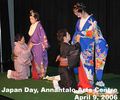
A total of 10 local Finnish women modeled the kimono.Apr 18, 2006
|
|
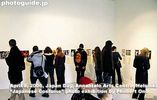
A steady stream of people came to see the exhibition of about 30 pictures.Apr 17, 2006
|
|
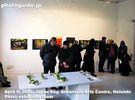
One wall also showed photos of Japanese temples by Elina Moriya, a Helsinki-based Japanese-Finnish photographer.So it was actually a joint photo exhibition by Philbert and Elina. How about that... When I first met Elina, I never dreamed something like this would happen.Apr 17, 2006
|
|
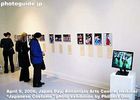
My video clips of Japanese festivals were also shown by a monitor.Apr 17, 2006
|
|
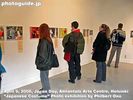
Photo exhibition room with "Japanese Costume" photos by Philbert Ono.Apr 17, 2006
|
|
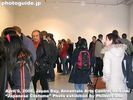
People crowding the photo exhibition room with "Japanese Costume" photos by Philbert Ono.Apr 17, 2006
|
|
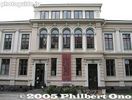
Annantalo Arts Centre, Helsinki. Their Japan Day event was held on April 9, 2006.A former primary school built in 1886, this distinguished-looking building is now an arts center for children and young people. They held a Japan Day event on April 9, 2006 when they presented Budo demonstrations, kimono show, workshops, Japanese food, lectures, and a photo exhibition featuring my pictures of Japanese costumes. My friend Elina Moriya also showed a few of her pictures of temples.
Annantalo Web site: [url=http://www.kulttuuri.hel.fi/annantalo/index_en.html[/url]Apr 17, 2006
|
|
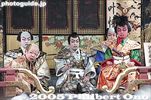
Hikiyama Festival, Nagahama, Shiga PrefectureHeld in mid-April, the Hikiyama Festival features authentic kabuki plays performed by young boys. Several ornate floats on wheels move around the city to serve as portable stages for these well-trained actors. The boys play both the male and female roles and wear gorgeous kimono. They undergo rigorous practice sessions during the months before the festival.
See more photos of this festival here.Mar 17, 2006
|
|

Costume PlayerPurin from Pokemon.
See more photos of cosplayers here.Mar 17, 2006
|
|

Costume PlayerIn Tokyo, large anime and manga fairs are held at convention halls such as Tokyo Big Sight and Makuhari Messe. Many cosplayers also attend these events and pose for photographers. You can see many anime, manga, and video game characters come to life in an incredible array of costumes.
See more photos of cosplayers here.Mar 17, 2006
|
|

Costume PlayerCosplay costumes are sometimes based on Japanese kimono and Japanese elements such as the cherry blossom. She's Sakura Shinguuji from a video game called Sakura Wars (Sakura Taisen).
See more photos of cosplayers here.Mar 17, 2006
|
|

Costume PlayerA vampiress.
See more photos of cosplayers here.Mar 17, 2006
|
|

Shinto Shrine Maidens, Taga Taisha Shrine, Shiga PrefectureMany Shinto shrines in Japan employ female attendants called "miko." They perform ceremonial dances, clean the shrine grounds, and sell charms at the shrine's gift shop. The shrine maiden's standard costume consists of a short, white kimono worn over a scarlet-red hakama (skirt-trousers). They usually wear their hair long, bundled on the back.
This picture was taken on New Year's Day when many people in Japan visit shrines to pray for a happy and safe new year. They perform a dance on the shrine's outdoor stage.
See more photos of this shrine here.Mar 17, 2006
|
|

Tekomai Children, Hie Shrine, TokyoHie Shrine in Tokyo holds the annual Sanno Festival in June. It consists of a parade and ceremony at the shrine. These children are dressed as tekomai geisha who originally provided side entertainment at festivals.Mar 17, 2006
|
|

Tekomai Geisha, Fukagawa Hachiman Festival, TokyoTomioka Hachimangu Shrine in Fukagawa, Tokyo holds the full-scale Fukagawa Hachiman Festival every three years in August. It is a parade of over 50 portable shrines preceded by a troupe of tekomai geisha.
Their colorful costume is partially masculine with trousers instead of skirts. Their right shoulder is "exposed" to show a peony flower design. They carry a red paper lantern imprinted with their names and use their right hand to drag along a metal wand. As they walk, they only sing traditional chant-like songs. They do not dance.
See more photos of this festival here.Mar 17, 2006
|
|

Hanagasa Festival, YamagataDuring early August, northern Japan holds several large-scale summer festivals. One of them is the Hanagasa (Flower Hat) Festival in Yamagata city. Held in the evening, it is a long parade of women dancing while wearing a flowered hat.
See more photos of this festival here.Mar 17, 2006
|
|

Awa Odori Dance, Yamato, KanagawaThe city of Yamato in Kanagawa Prefecture holds its annual Awa Odori dance during the last weekend in July. Numerous Awa Odori dance troupes (including those from Tokushima) participate in the evening dance parade in the city's main streets.Mar 17, 2006
|
|

Awa Odori Dance, Koenji, TokyoIn late August, Koenji in Tokyo holds one of the largest Awa Odori dances outside Tokushima Prefecture. This woman is a different type of Awa dancer. She wears a head band, a happi coat imprinted with the name of her dance troupe, a pair of white shorts, and a pair of white sock-like shoes called tabi.Mar 17, 2006
|
|

Awa Odori Dance, Yamato, KanagawaThe dance is accompanied by taiko drums and other traditional music. This woman was strong enough to be "one of the drum boys." She wears a head band and a full-length yukata.Mar 17, 2006
|
|

Awa Odori Dance, Yamato, KanagawaAwa Odori dancers are characterized by their straw hats, a thin kimono called the yukata, and geta clogs. Their heels don't touch the ground, so they dance on their toes. They hop along while shaking their hands above their heads. Since the dance is performed in the summer, often the yukata gets soaked with perspiration.Mar 17, 2006
|
|

Kamogawa Odori Geisha Dance, KyotoA scene from the annual Kamogawa Odori dance held in May in Kyoto. She wears a multi-layer kimono whose colors contrast well with each other. This type of kimono was worn by the nobility.
See more photos of this dance here.Mar 17, 2006
|
|

Aoi Festival, KyotoHeld in May, the Aoi (Hollyhock) Festival is one of Kyoto's Big Three festivals. It is a long parade of people dressed in historical costumes from the Heian Period (794-1185) when Kyoto was Japan's capital. Each participant also wears a small branch of hollyhock.
See more photos of this festival here.Mar 17, 2006
|
|

Back of a Maiko, KyotoThe maiko is an apprentice geisha (or geiko). She can be easily identified by the long length of her kimono sleeves and the long length of her obi sash on her back.
See more photos of Kyoto geisha here.Mar 17, 2006
|
|

Aoi Festival, KyotoThe parade proceeds through a long route in Kyoto, taking a few hours.
See more photos of this festival here.Mar 17, 2006
|
|
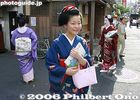
Geisha and Maiko in KyotoThis is in Pontocho, one of Kyoto's geisha districts. The woman on the left is a geisha (called "geiko" in Kyoto), the woman in the middle is a helper, and the woman on the right is a maiko or apprentice geisha. They are on their way to see the Kamogawa Odori dance performed by the Pontocho geisha in May.Mar 17, 2006
|
|

Costume PlayersJapan has long been home to anime cartoons, manga comics, and video games. But it was only from the mid-1990s when it became very popular for teenagers and young women to dress up as characters from their favorite anime, manga, or video game. They congregate at manga, video game, and anime fairs where they pose for hordes of photographers.
They either buy or make their costumes. They depict so many characters that it's impossible to recognize all of them unless you ask them who they are costumed as. The girl on the left is dressed as Felicia from Vampire Savior.
See more photos of cosplayers here.Mar 17, 2006
|
|
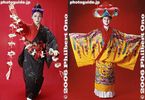
Okinawan KimonoOkinawa is a chain of subtropical islands in southern Japan between Kyushu and Taiwan. It developed its own language and culture while it was an independent kingdom centuries ago. Okinawan kimono, hairstyles, and dances therefore look quite different from the rest of Japan.
On the left is an Okinawan dancer wearing a kimono with her right arm exposed outside the sleeve. The dance is called "Nuchibana" (flower lei) featuring a string of red and white flowers. The dance expresses the feelings of a young woman in love.
The dancer on the right is wearing an Okinawan kimono called the bingata, perhaps Okinawa's most famous kimono. The design is made by applying dyes through a stencil. It was originally worn by Okinawa's royal family members. It is now the costume of a slow-moving Okinawan dance called "Yotsudake."Mar 17, 2006
|
|
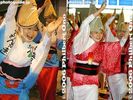
Awa Odori Dance, Koenji, TokyoThe Awa Odori is a summer dance festival originally from Tokushima Prefecture in Shikoku. It has spread to other cities such as Koenji, Tokyo and Yamato, Kanagawa Prefecture. It is a simple dance accompanied by an infectious drum beat. The hands are raised above the head and shaken. It is the same gesture as saying, "I'm a fool." Hence, it is nicknamed the "Fool's Dance." It is originally a Buddhist bon dance held in August to welcome back the souls of the deceased returning to visit Earth. The crescent moon-shaped straw hat is one symbol of the dance.Mar 17, 2006
|
|
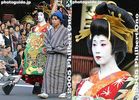
Oiran Courtesan Procession, TokyoOn Nov. 3, Japan's Culture Day holiday, the Tokyo Festival of the Ages (Jidai Matsuri) is held in Asakusa, Tokyo. It is a long parade of people dressed in historical costumes tracing the history of Tokyo. One highlight is the Oiran Dochu, a procession for a high-ranking courtesan called "oiran." One of the trademarks of the oiran was her very high and heavy platform clogs. She walks in a very stylized figure 8 pattern. Her hair also has many ornaments.
See more photos of this festival here.Mar 17, 2006
|
|
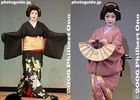
Kagurazaka Geisha Dance, TokyoMost people associate the geisha with Kyoto. However, Tokyo also has authentic geisha. Kagurazaka is one of the few remaining geisha districts in Tokyo. The Kagurazaka geisha give public dance performances in spring called "Hana no Kai" (Glamorous Gathering). They have proven to be very popular with sold-out performances every year. The geisha change into different kimono as they perform graceful dances and musical plays.
See more photos of this dance here.Mar 17, 2006
|
|

In case you missed the exhibition, you can see most of the pictures on this page. Lion Dance above.From a kabuki dance called Renjishi, this is one of Japan's most famous and dramatic costumes. The dance is usually performed by a father and son both appearing first as ordinary dancers holding a lion mask. Later, they transform into fierce-looking lions, the father with long white hair and the son with long red hair. The dance climaxes with both father and son spinning their hair furiously in the air accompanied by quick drum beating and music. A similar kabuki dance called Kagamijishi features only the white lion.Mar 17, 2006
|
|

Wolverine movie clip (High-speed) クズリのムービーI used my digital video camera to film this wolverine grabbing a huge piece of pig carcass and carrying it for some distance until he dumped it out of fear. But it shows how strong these animals are. They can carry a carcass three times their own weight. Wolverines belong to the same family as weasels. They have sharp teeth and claws. The picture is not very sharp, maybe because of the rain. The sound has been erased. The movie clip is 1 min. 36 sec.
クズリが現れて豚の死がいの大きい部分を持って行こうとしたが、間もなく放置して逃げた。自分より重いものを運べる強い動物である。96秒のムービー。Oct 17, 2005
|
|
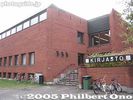
Kuusamo Library クーサモ図書館This is the public library in Kuusamo to which I donated a bunch of Japanese nature photo books, magazines, and a DVD (see the previous images).
Before leaving for Finland, I requested and received a photo book from the three Japanese photographers I featured in my third slide show. I also went to a large bookstore in Tokyo and scoured all the Japanese nature photo books. I bought some books I thought would be of interest in Finland. I packed all the books in my suitcase, and when I checked in at Finnair at Narita Airport (Tokyo), they told me that my suitcase was overweight by 6 kg or so and I would have to pay extra. I asked how much, and she said 40,000 yen (about $300).
I couldn't believe it. I almost went ballistic. First I made sure that I heard correctly: "You mean 4,000 yen ($30) right?" No, it was 40,000 yen. I panicked inside, but tried to remain calm. Then I dropped down and opened my suitcase on the spot and took out 6 kg worth of books and stuffed them in a large plastic bag which they kindly provided.
Now I had two pieces of carry-on luggage and one lighter suitcase weighing right below the 25kg limit. "Fine" she said, and I was happy even though I was slightly weighed down.
It was worth the trouble because I later found out that the Kuusamo library had no photo books from Japan. But now they do.
Library Web site: http://www.kuusamo.fi/Resource.phx/sivut/sivut-kuusamo/kirjasto/index.htx
フィンランドへ行く前に都内の大手本屋さんへ行って日本の面白そうなネイチャー写真集を何冊も買って持って行きました。今森光彦、中村郁夫、栗林慧先生から頂いた写真集と合わせてスーツケースに入れた。そして成田でFinnairでチェックインすると重さ制限(25kg)がオーバーで追加料金がなんと4万円!!とんでもない話で、その場でスーツケースを開けて6kg分の重い本を手持ちにした。それでOKだった。
これらの寄贈写真集は、スライドショー中にも紹介して「図書館で借りられる」と皆さんに知らせました。来場者からも写真集やDVDの注文も何件か受付ました。Oct 12, 2005
|
|
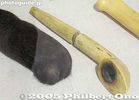
Pipe made of mammoth bone ネネッツ族の展示This exhibit was presented by Markku and Johannes Lehmuskallio and Anastasia Lapsui who studied and filmed the Nenets and other tribes.Oct 12, 2005
|
|
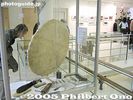
Instruments and implements of the Nenets tribe ネネッツ族の展示Drum and other implements.
This exhibit was presented by Markku and Johannes Lehmuskallio and Anastasia Lapsui who studied and filmed the Nenets and other tribes.Oct 12, 2005
|
|
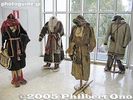
Native clothing of Nenets tribe ネネッツ族の衣類The Nenets tribe live in the polar region of northwestern Siberia in Russia. They are Arctic reindeer pastoralists with huge herds of reindeer. Their faces look Asian or Mongoloid.
This exhibit of Nenets clothing (made of reindeer skin/fur) was presented by Markku and Johannes Lehmuskallio and Anastasia Lapsui who studied and filmed the Nenets and other tribes.
They brought a whole load of other exhibits (see next image) to Kuusamo Hall.
ホールのロビーに写真以外にもいろいろの展示物があった。これは、シベリアにいるネネッツ族の衣類。ほとんどトナカイの毛皮で作られている。Oct 12, 2005
|
|

My Bears, by Lassi Rautiainen フィンランドのヒグマの写真集Lassi is the main man behind the Kuusamo Nature Photo festival. He is also a well-known nature photographer in Europe and his special passion is bears ("karhu" in Finnish).
This is his photo book of "his" bears in the Finnish (and maybe Russian) wilderness photographed from his bear hides (wildlife observation huts). The text is in four languages including English. One of the first things he says in the book is that bears are not dangerous. They do not attack people. Well, that's not true in Japan. Bears do attack and kill people in Japan. People picking mushrooms in the mountains or even in their backyard near a mountain can be vulnerable.
Bear attacks are often widely reported in Japan's news media. So I was surprised to hear that bears in Finland are afraid of people and run away when they see humans. Finland has about 1,000 brown bears. Happily, I saw two of them during a bear-watching trip conducted by Lassi.
The book is quite interesting. Lassi gives colorful names to all the bears he has seen. There's Flathead, Ruffled-head, Little Boy, Beefcake, and Split-ear, Finland's most photographed bear. Split-ear's right ear has a little V-notch on the tip. He got it by tearing off the tag that a bear researcher had tacked on.
Lassi also tells interesting stories about the mating practices of the bears (occurring in May-June), and about his own encounters with the bears. The book also shows pictures of wolverines which look like badgers. I was lucky to observe and film a wolverine at a bear hide. There are only a few hundred of them in the Nordic region.
Lassi is a great nature storyteller and often humorous. And I read this book from cover to cover with great interest. Published by his company, Articmedia. ISBN: 951-95376-6-X
「僕のヒグマ」という写真集で、フィンランドで撮ったヒグマの写真。写真家のラッシー・ラウティアイネン氏(Lassi Rautiainen)は長年のヒグマのオタク。クーサモのネィチャーフォト祭りの実行委員長でもある。面白い方です。Oct 12, 2005
|
|
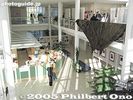
Kuusamo Hall lobby ホールのロビーHanging on the 2nd floor balconey on the right is a teepee made of reindeer skin. Reindeer skin is very strong and can last many years. It also keeps the teepee warm.
This teepee exhibit was presented by Markku and Johannes Lehmuskallio and Anastasia Lapsui. They brought a whole load of other things (see following images) and photos to display at Kuusamo Hall.
ホールのロビーに写真以外にもいろいろの展示物があった。Oct 12, 2005
|
|

Photo books for sale フィンランドの写真集の即売Nature photo books published in Finland and by some of the photographers featured at the festival were also displayed for sale. The next few images show a few of the books that were available (and which I bought).
フィンランドの写真集も即売されていた。何冊も買って次に紹介する。Oct 12, 2005
|
|

Letter of Thanks from PhilI really enjoyed my first trip to Finland during September 4-18, 2005 (Sept. 8-17 in Kuusamo) and savored every hour. The people in Kuusamo were all so nice and it was a great pleasure to meet and see the work of many talented and dedicated photographers from Europe.
They have definitely piqued my interest and opened my eyes to the nature and wildlife in northern Europe and the Arctic region. I've also become much more keenly aware of the seriousness of global warming. People in Finland have told me how the climate has become noticeably warmer over the decades. Such countries near the polar regions are the first to feel and see the detrimental effects of global warming. I really hope we can someday reverse the trend.
I want to thank the people who made my sponsored trip and participation in Kuusamo Nature Photo 2005 possible and very enjoyable. After months of email correspondence with the festival staff, it was great to finally meet all of them face to face. It makes a big difference when you know the face and person behind the name.
I know they worked very hard to pull off a very successful nature photo festival. For all the email correspondence, coordination, and making all the arrangements, I especially want to thank the following:
Lassi Rautiainen, Kuusamo Nature Photo Director
Pekka Pirhonen, Kuusamo Culture Department Manager
Seija Väisänen
Hannele Pappila
Town of Kuusamo
Corporate sponsors
I also want to personally thank the following people:
Pirkko Väätäinen, my interpreter who interpreted my three slide shows into Finnish.
Hannu Hautala and wife Irma, for having us over at his home/office. Despite his fame, Hannu is a very down-to-earth and warm-hearted man. It was a great pleasure to meet him, to see his collection of Japanese photo books, and hearing about his two trips to Japan.
Barbara, for videotaping my slide shows with my video camera and taking some great snapshots of me enjoying myself in Kuusamo. And also for providing transportation to/from the airport.
Tõnu Ling, for taking snapshots of me in Kuusamo and being my first friend in Kuusamo (we met on the plane to Kuusamo).
Koillis sanomat newspaper and reporter Tuomo Pirttimaa for interviewing me in an article they published.
Again, I have to thank Lassi for everything. He was the one who took care of all the details even during our nature trips. Lending sleeping bags, carrying hot drinks in heavy thermos bottles, driving us all over the place, answering all our questions, taking pictures of us, and making sure everyone had an enjoyable time. He turned out to be quite humorous. I can highly recommend him to anyone who needs a very knowledgeable local guide to watch or photograph wildlife in Finland.
See his Web site: Articmedia
Finally, I want to thank all the people and photographers I met at Kuusamo for their pleasant company and friendship. Remember that you have a friend in Japan. If you ever come and visit, let me know.
Meanwhile, I hope you enjoy this permanent online gallery of Finland photos explained in both English and Japanese.
Philbert Ono
Tokyo, Japan
P.S. In case you don't know, "kiitos" means thank you in Finnish.Oct 12, 2005
|
|

To Everything a Season, by Hannu Hautala and Markku Lappalainen 写真家ハンヌ・ハウタラHannu Hautala is Finland's most well-known nature photographer. Even in Helsinki's biggest bookstore, you can find a "Hannu Hautala" postcard rack.
I also had the pleasure of meeting him and visiting his home/office. He has been to Japan twice where he photographed Japanese cranes in Hokkaido and snow monkeys in Nagano. He also has a substantial collection of Japanese nature photo books. He is very warm-hearted and well-liked by everyone.
This book is in English (that's why I bought it), and it shows pictures of Finland's nature, wildlife, and landscapes for each month of the year from January to December. The text is also interesting as it explains the daily and seasonal lives of the wildlife. Published by Otava in Finland. ISBN: 951-1-14888-5
フィンランドの一番有名なネイチャー写真家であるハンヌ・ハウタラ氏(Hannu Hautala)の写真集。英語版で1月から12月のフィンランドの自然を紹介している。野鳥や風景が多い。クーサモ在住のハウタラ氏は、とても優しい人。Oct 12, 2005
|
|
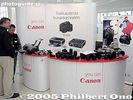
Canon booth スポンサーのブースCanon was one of the festival sponsors and had a booth in Kuusamo Hall where they proudly displayed the new EOS 5D full-frame digital SLR camera. It was here where I held this new camera for the first time and salivated. First thing you notice is the huge viewfinder picture. And it's only slightly larger than the EOS 20D.
キヤノンが一つのスポンサーであった。出たばかりのEOS 5Dも展示された。Oct 12, 2005
|
|

Kuusamo Luontokaupunki, by Paavo Hamunen, Hannu Hautala, and Lassi Rautiainen クーサモの写真集I first saw this book at the Finnish Tourist Board's office in Tokyo (Imperial Hotel) which I visited before going to Finland. I think it is the only nature photo book about Kuusamo with Japanese text. It also has text in Finnish, Russian, and Italian (but no English!).
It shows pictures of the best nature spots in and around Kuusamo such as Julma Ölkky, Kitkajoki River, and Näränkä, the three places I visited (or experienced) while in Kuusamo (click on links to see my pictures). Published by Articmedia in 2000.
ISBN: 951-98612-0-3
唯一の日本語も含むクーサモの自然を紹介するの写真集。東京にあるフィンランドの観光局(帝国ホテル内)にもこの本が置いてあった。Oct 12, 2005
|
|
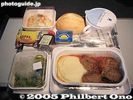
Finnair: Helsinki to TokyoMeatballs and mashed potato.Oct 12, 2005
|
|
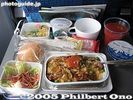
Finnair: Tokyo to HelsinkiThe food wasn't so bad.Oct 12, 2005
|
|
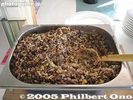
Fried rice or pilafIn Kuhmo.
My question is, is there a Finnish restaurant in Tokyo?Oct 12, 2005
|
|
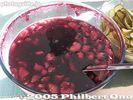
DessertOct 12, 2005
|
|

Pudding dessertOct 12, 2005
|
|
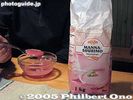
Pudding dessertOct 12, 2005
|
|

Main dishAt Kuusamo Sokos Hotel restaurant.Oct 12, 2005
|
|
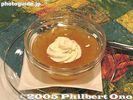
Dessert: Cloudberry puddingCloudberry is a delicacy from Lapland. I bought some cloudberry jam at Helsinki Airport. Someone should import it to Japan.Oct 12, 2005
|
|

TartAt Kuusamo Hall.Oct 12, 2005
|
|

Reindeer meat + potatoesThe delicious dinner we had when we went to the Finnish sauna and saw the aurora.Oct 12, 2005
|
|
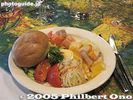
SaladAt Kuusamo Sokos Hotel restaurant.Oct 12, 2005
|
|

Picnic food (at Suomenlinna)Oct 12, 2005
|
|

TomatoesIn supermarket. The leaves at the top of the tomato are removed. They look bald. Something we don't see in Japan.Oct 12, 2005
|
|
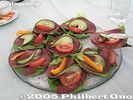
Reindeer toppingMy first dish at Kuusamo. Delicious.Oct 12, 2005
|
|
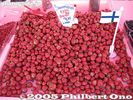
BerriesAt Market Square.Oct 12, 2005
|
|
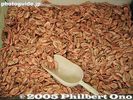
ShrimpIn supermarket.Oct 12, 2005
|
|
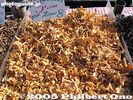
Dried mushroomsAt Market Square.Oct 12, 2005
|
|
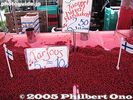
BerriesAt Market Square.Oct 12, 2005
|
|

Piirakka tartsOct 12, 2005
|
|

Home-cooked mealI forgot the name of this pea soup, but it was good.Oct 12, 2005
|
|

Geisha chocolate ゲイシャ チョコSome years ago, when a Finnish friend visited Japan and gave me this Geisha chocolate from Finland, I was very amused. Why in the world did they name it "geisha??" It's milk chocolate with a soft hazelnut filling.
Then when I went to Finland, I was surprised to see this chocolate brand almost everywhere. It's made by a company called Fazer, and when you look at their Web site, they explain in Finnish why they named it "geisha." (Wish I could read it.) The logo on the packaging uses a nice drawing of a geisha. But at the company's Web site, they have a wallpaper gallery showing a real human modeling as an obviously fake geisha.
No offense to the company, the model, makeup artist, and chocolate, but she is one of the worse-looking geisha models I've ever seen. Egad!! She might even be a man.
Take a look: http://www.fazermakeiset.fi/ Click on the Geisha button, then click on the fourth candy from the top to see the wallpaper.
After careful analysis, I know why Fazer's geisha looks so awful: Her fake wig is way too high above her ears. It's too small or too short for her (or his) head. The wig was probably for a young girl. See this photo and compare. They should stick to the cartoon logo instead.
この「Geisha」チョコはフィンランドに大人気。何故そう名付けたか分かりませんが(フィンランド語の説明がある)、数年前に初めてフィンランドの友人からもらったとき爆笑だった。そしてフィンランドへ初めて行ってこのGeishaチョコがどこでもあって驚きました。
Fazerという会社が作っていてHPを見るとなんと人間の「ゲイシャ」のモデルさんも登場している。このゲイシャのモデルもとても見苦しい。よく見ると、その桂が小さ過ぎて(または高すぎる)耳が丸見えてとても変な感じ。
HP: http://www.fazermakeiset.fi/
Geishaのボタンをクリックして、上から4番目のキャンデイをクリックするとそのモデルの壁紙がでる。いかがでしょうか。Oct 12, 2005
|
|
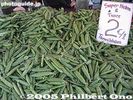
BeansSomething like beans in a pod. Sweet. At Market Square.Oct 12, 2005
|
|
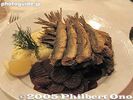
Baltic herring バルト海のニシンA specialty of Helsinki. This was served at Sea Horse, a well-known restaurant. This one serving must have had about 20 of these herrings stacked up. I ate maybe 10 of these fish. They were excellent, but I could eat no more. Took the rest home in a doggy bag. It took another 3 days to eat the rest.
一人分になんと20匹も積み重なっていた。多すぎて残った分を持ち帰った。Oct 12, 2005
|
|

Lunch (reindeer meat) 肉はトナカイKuusamo Hall also has a restaurant serving good food.
ホール内はレストランもある。Oct 12, 2005
|
|

Kuusamo Nature Photo 2005 Program プログラムCover of the program distributed free. It has the schedule of all the slide shows and introduces the photographers. Cover photo (bird with firey eyes) by Rob Jordan from the UK.
Below is the complete program schedule taken from this program (in Finnish only):
Friday, September 9
KUUSAMOTALO
Musiikkiesitys klo 18 8 €
Muu ohjelma 19.15 alkaen 6 €
Alle 12 v. vapaa pääsy
Viikonloppukortti 9.-11.9. 35 €
Viikkokortti 9.-18.9. 70 €
Juontaja: Markku Heikkilä
17.00 Näyttelyjen avaus (vapaa pääsy)
Kuusamon kaupunginvaltuuston pj Matti Heikkilä
18.00 Ankaruusindeksi
musaa ja luontokuvia, DVD + live
Työryhmä: Käsmä-Harju-Salmirinne
Luontokuvat: Lassi Rautiainen
18.30 TAUKO (Intermission)
19.10 Nature Photo valokuvakisan tulokset 30’
Metsähallituksen puheenvuoro
Japanin luonnon esittelyä
Introduction to Nature in Japan Philbert "Phil" Ono, Japan 45’,
20.30 Tauko
21.00 Terra Borealis 50’, slides
Andy Horner, Ahvenanmaa
Yellowstone 20’ slides 6x4,5
Mara Fuhrmann, Saksa
22.15 Tauko
22.30 Päin seiniä
Jorma Luhta (ulkona, sateella sisällä)
Sat., September 10
Juontaja: Hannele Pappila
10.00 Avaus Hannele Pappila
10.15 Maisemakuvan traditioita
Ismo Luukkonen
11.00 Myyttinen maisema - kuvia saamelaisten
pyhistä paikoista
Arvid Sveen, Norja
11.45 Tunturi ja Meri – maisemakuvia Finnmarkista
Sonja Siltala, Norja
12.30 TAUKO
13.30 Luontomuseo
Ilkka Halso
14.15 Lost in between - pakolaisena pohjoisessa
Minna Kurjenluoma
15.30 Fields Studies
Martina Motzbächel
16.15 TAUKO
16.45 Maan ja taivaan välillä
Tauno Kohonen
17.30 Maisemakuvaajan ylä- ja alamäkiä
Kalervo Ojutkangas
18.00 TAUKO
18.15 - Japanilaisen luontokuvan traditioita
19.15 Nature Photography in Japan Philbert "Phil" Ono, Japan
Sun., September 11
Juontaja: Markku Heikkilä
10.00 Japanilaisten luontokuvaajien esittelyä 50’
Three Japanese Nature Photographers Philbert "Phil" Ono, Japan
Luontokuvii Turust - ei virallissi mut torellissi 20’
Markku Heikkilä
11.15 Tauko
11.30 Pohjoisen luontokuvaajat ry 50’
Luontoa läheltä - Erkki Toppinen
Mullan tuoksua ja purojen solinaa -
Markku Välitalo
Evoluutiota vai sattumaa? - Jari Wilenius
Digiuutisia, Canon 10’
12.30 Tauko
13.30 Saamenmaa, DVD-esitys Lapista 28’
Pekka Antikainen
Iceland, slides 6x4,5 35’
Mara Fuhrmann, Saksa
14.40 Tauko
15.00 Den extrema naturbilden 20’
Andy Horner, Ahvenanmaa, slides
Siipiveikot - tilannekuvia linnuista 30’, flap top
Tomi Muukkonen, Jari Peltomäki,
Markus Varesvuo
16.00 Päätös
Mon., September 12
Juontaja ja tulkki: Kaari Saarma
18.00-21.30 VIRON LUONTOA
Viron vuoden luontokuvat 10’
Eestimaa energiad: retk läbi aasta / Viron
energiat: retki läpi vuoden, 30’ Arne Ader
Precious moments with Estonian birds and
landscapes / Lintuja ja maisemia, 30’
Mati Kose
Tauko 15’
Mielikuvia ja mielitekoja – abstrakteja kuvia
luonnosta, 20’ Kaari Saarma
Luonto kaupunkilaisen silmissä, 20’
Heiko Kruusi
Tauko 15’
Tiny diversity / Hyönteisten maailmasta, 30’
Urmas Tartes
Maalaispojan maisemat 15’, Tõnu Ling
(September 13-14, optional photo safari trips)
Thu., September 15
Juontaja: Jaakko Heikkinen
18.00-21.30 SAKSAN KUVAAJIEN ILTA
Lepakot, Dietmar Nill 60’
Tauko 15’
Revontulet 30’ ja Kaakkuri 30’,
Hinrich Basemann
Tauko 15’
Paradise in Packice / Huippuvuorilla 50’
Karl-Heinz Georgi
Fri., September 16
Juontaja: Jaakko Heikkinen
18.00 Sävystä sävyyn - erämaan hengessä
Kuvanauhalle leikattu valokuvaesitys luonnon
väreistä livenä soitetun pianon säestyksellä
Kuvat: Hannu Hautala
Piano: Heikki Sarmanto
Kuvanauhan leikkaus: Lauri Kettunen
18.45 Tauko
19.00 Onnen Maa 40’
Hannu Hautala
Kaksi taivasta 20’
Fabrizio Carbone, Italia
20.00 Tauko
20.30 Safareilla
Annelie Utter, Ruotsi
21.30 Tauko
21.45 Kotkia ja muita lintuja
Der wilde Osten – von Schreiadler, Seeadler und
vielen andere fliegende Vögel
Dietmar Nill, Saksa
Sat., September 17
Juontaja: Juha Säkkinen
10.00 Digimaailma
Sakari Nenye
11.15 Tauko
11.30 Digimaailma jatkuu
12.45 Safareilla 20’
Annelie Utter
13.10 Tauko
14.00 Namibian Farytale / Namibiassa 35’
Karl-Heinz Georgi, Saksa
Arktis 30’
Hinrich Basemann, Saksa
15.10 Tauko
15.20 The secret lake of the firey eyes / Palavien
silmien salaperäinen järvi
Rob Jordan, Englanti
16.30 Tauko
17.00 Luontolyriikkaa
Heikki Sarmannon sävellyksiä suomalaiseen
lyriikkaan (mm. Leino ja Hellaakoski)
Piano: Heikki Sarmanto
Solisti: Maija Hapuoja
Kuvitus: Kaamoskamera:
Paavo Hamunen, Mika Jaakkola, Matti Jääskö, Heikki Ketola, Ritva Larikka, Janne Moilanen, Verner Nivala, Marketta Tornberg ja Petteri Törmänen
Sun., September 18
Juontaja: Juha Säkkinen
Teema: luontofilmit
10.00 Paimen ja kitara, musavideo 4’
Johannes Lehmuskallio
Paimen-filmi 60’
Markku ja Johannes Lehmuskallio
11.15 Tauko
11.30 Digivideo, Lauri Kettunen
12.30 Tauko
13.00 Nenetsien kulttuuria 10’
Seitsemän laulun matkassa, filmi 25’
(Pekka Martevo)
Uhri, filmi 52’
Anastasia Lapsui, Johannes ja Markku Lehmuskallio
14.40 Tauko
15.00 Korpi – legenda Ludvig Löppösestä
video 30’
Pekka Koskinen ja työryhmä
15.40 PäätösOct 12, 2005
|
|
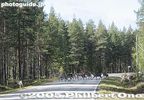
Reindeer crossingOct 10, 2005
|
|

Outdoor toilet 野外のトイレOct 10, 2005
|
|
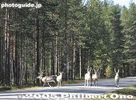
Reindeer またトナカイA few of the reindeer are looking at us because our guide Lassi gave out his reindeer love call. They look up to see what's there, we take their picture, then they run.
Most reindeer have a collar around the neck which has the owner's contact information in case it ends up as roadkill.
Reindeer often cross the road, so they can cause traffic accidents.Oct 10, 2005
|
|

Reindeer food トナカイの大好物LichenOct 10, 2005
|
|
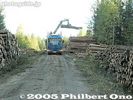
Log loader 道路の障害In Finland, sometimes you will come across a log loader like this one blocking the road. We waited for about 20 min. until he finished his job and left the scene.
車の中に20分ほど待ってやっと用を済ましてどけてくれた。Oct 10, 2005
|
|
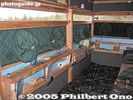
Inside bear hide ヒグマ観察小屋の中Below the slit window are holes for camera lenses. Tripod heads are also provided. There is enough sitting room for four to six people. The bench on the right can also be folded up to make enough floor room for four people to sleep in sleeping bags. The floor was made of cushion material.
Compared to the outside temperature, it was quite warm inside. I thought this hide was very well-designed. The best hours for watching wildlife was a few hours before dark and after daybreak. During midday, we drove back to our real lodge for hot meals and a shower. Then we returned to the hide a few hours before dark.
At night, it is too dark to photograph anything. During my one night and two days in the hide, I was lucky enough to see a wolverine (see movie clip) and two bears.
Our guide, Lassi Rautiainen, offers wildlife photo safaris in Finland at hides like this one.
Web site: Articmedia
この観察小屋は、4〜6人が入られる。中にのぞき窓があって、その直ぐ下にカメラレンス用の穴がある。三脚の雲台も用意されている。そして座れるベンチが折りたたみ式で上に固定するとクッションが敷いている床に寝袋で4人が寝られる。ここで一晩を過ごした。(いびきがひどい人がいると辛い。あまり寝られなかった。)
外の気温と比べると中はずっと暖かい。4人もいると自然に暖かくなる。暖房は特になかった。ここで日暮れ前と夜明け後の数時間にじっとして野生動物の出現を待つ。
トイレは外。外に誰もいないので女性でも大丈夫。ただし、野生動物が人間の匂いとか音に非常に敏感で動物がいないことを確認してから外へ。シャワーと水道もないのでウェットティシュが便利。カメラ機材、食べ物も飲み物も持って行く。
日中は、動物の活躍があまりないので、車へ戻ってちゃんとした宿泊先で食事やシャワーを。運良くヒグマとクズリを見た。Oct 10, 2005
|
|
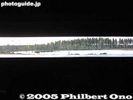
Bear hide window のぞき窓Inside the hide, the narrow window provided a good panoramic view of the area. We were required to whisper and not make any loud noises which would scare the animals away.
There's no guarantee of seeing anything, so it's a waiting game. You might see a bear or you might not. But the more days/nights you spend in the hide, the greater the chances of seeing something.
On the day before, our guide had placed a pig carcass near the hide as bait to attract bears and wolverines. This was standard practice and obviously increases the chances to see wildlife.
野生動物(特にヒグマ)が出没するかどうか全く保証できないため、2〜3晩に泊まった方が当然出没する確率が高くなる。観察の前日には、ガイドさんが豚の死がいを近くに置いてくれる。Oct 10, 2005
|
|

Inside bear caveOct 10, 2005
|
|
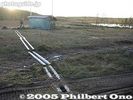
Bear-watching hut ヒグマ観察小屋This is one of the bear-watching huts (called hides) in the Kuhmo wilderness operated by our guide Lassi Rautiainen (see Articmedia). It was close to a pond in the wetlands.
Kuhmo is near the Russian border near the town of Kajaani. It took about 4 hours to drive from Kuusamo.
湿地の荒野のところで、板の上に歩く。Oct 10, 2005
|
|

Bear cave クマのほら穴Small bear cave for hibernation. This was a short walk from the road.Oct 10, 2005
|
|
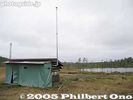
Bear hide ヒグマ観察小屋It's a cross between a tent and mountain hut, but perfect for watching and photographing bears and wolverines. The exhaust pipe on the right is made tall so that the wildlife don't smell the humans inside and get frightened away.
野生動物にとってかなり不自然な不気味な建物だけど、ネィチャーの観察のためでは効果的だそうです。右側に排気管を高くしている。人間の匂いが動物に届かないために。Oct 10, 2005
|
|
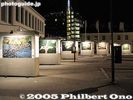
Outdoor photo exhibition at Glass Palace 野外の大型写真展In September 2005, there happened to be an outdoor photo exhibition at the Glass Palace inner yard. They were poster-size photos of the "Earth from Above" by French photographer Yann Arthus-Bertrand.Oct 10, 2005
|
|
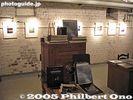
Lanterna Magica bookshop and exhibition spaceThe bookshop also has small exhibition rooms.
この古本屋は、ギャラリーもあった。Oct 10, 2005
|
|
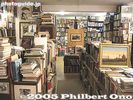
Lanterna Magica antiquarian bookshopOct 10, 2005
|
|
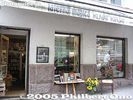
Lanterna Magica bookshop 古本屋Somewhat out of the way (difficult to find parking), but a nice shop to find some old books, including photography.
ヘルシンキの有数な古本屋さん。Oct 10, 2005
|
|
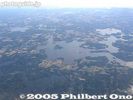
Finland: Land of Lakes 湖だらけの国When you look at a map of Finland or see it from the air, the first thing you notice is that it has a lot of lakes. Ten percent of the country is covered by lakes, but from the air over the southern half, it looks like least 30%-40% of the land is water.
It looked like a field of giant puddles or one giant marshland. It was like the country was sinking into ocean. I had never seen so many lakes in my life. Incredible. And if it's not water, it's forests. Some 70% of Finland is covered by forests.
I think Finland will someday become a popular tourist destination, especially for people who need to escape the urban hustle-bustle and stressful lifestyle. There are nothing like trees and lakes which can pacify humans.
Basic intro to Finland: http://virtual.finland.fi/
Finland map: Virtual Finland map
上空からも直ぐ分かるけど、フィンランドは湖がとっても多い国。20万弱の湖。面積の一割が湖。なんと国の7割は森林。湖と森林は、人を癒すものである。
HP: フィンランド政府観光局(日本語)Oct 06, 2005
|
|
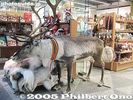
Stuffed reindeer トナカイAt Helsinki Airport, a gift shop was selling reindeer furs for about 60 eur. I was tempted to buy one. The gift shop also sold canned reindeer meat (as well as bear and elk meat) and reindeer salami. In Finnish, reindeer is called "poro," and in Japanese, "tonakai."
Until I visited Finland, I thought reindeer were fictional animals since I knew that there couldn't be any animals which could pull a sled and fly in the air. I was delighted to find that reindeer were real animals and they looked just like the ones that pull Santa Claus. They just cannot fly. And none have a red nose. (Correct me if I'm wrong.)
Here's a picture of a real reindeer I took in Finland.
ヘルシンキ空港でトナカイの毛皮を売っていた。着る用ではなく、布団でも使えるもの。約60 eur。フィンランドではトナカイがよく見かけた。Oct 06, 2005
|
|

A photographer's carObviously.Oct 05, 2005
|
|

Wiping off the hailMy feet was near freezing even though we were wearing boots. The hail made it even colder. Our guides made us run up and down a hill before we went back to the hail-covered raft. My feet were still cold.Oct 05, 2005
|
|
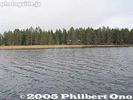
Lake JuumaThere's a law in Finland where lakeside summer cottages must be at least 200 meters apart.
We also passed by the Finnish Prime Minister's (or maybe president) summer cottage. I was surprised that there was no security in that area.Oct 05, 2005
|
|
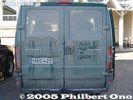
Also Available in GreenOur main means of transportation for our nature trips out of Kuusamo. Rented of course. In rural areas of Finland, many of the roads are unpaved. And when it rains, your car can easily get dirty.Oct 05, 2005
|
|
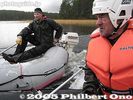
Our guidesI asked them what they do during the winter: They offer reindeer sled rides.Oct 05, 2005
|
|

Sudden hailSuddenly, it hailed. Our helmets came in handy for the onslaught of little ice pellets.Oct 05, 2005
|
|
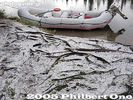
HailOct 05, 2005
|
|
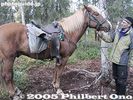
Finnish horse and ownerOct 05, 2005
|
|

Delicious Finnish sausagesOne of our friendly guides smiles for camera.Oct 05, 2005
|
|
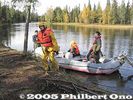
Lunch breakOct 05, 2005
|
|

Picnic placeOct 05, 2005
|
|
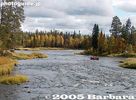
Almost autumn colorsOct 05, 2005
|
|

A piece of cakeOur guide instructed us as to when to start paddling forward or backward.Oct 05, 2005
|
|

Easy rapidsOur guide instructed us as to when to start paddling forward or backward.Oct 05, 2005
|
|

Shooting the rapidsOct 05, 2005
|
|
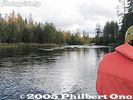
Cruising with outboard motorWe had oars, but an outboard motor also propelled us on the water.Oct 05, 2005
|
|
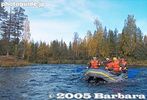
One paddle, two paddleThat's me wearing the red helmet.Oct 05, 2005
|
|
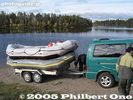
Great day for raftingBut later we had hail.Oct 05, 2005
|
|

Life jackets, helmets, waterproof jacket/pants, boots, and glovesFirst we had to suit up. It was like we were ready for combat. But it wasn't that dangerous.Oct 05, 2005
|
|
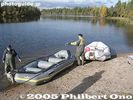
"If you fall out, just float and do nothing. We'll grab you back in."Before we started off from Käylä, our guides gave us basic instructions such as what to do if we fell out of the raft. (Don't do anything and just float until someone grabs you and pull you back into the raft.)Oct 05, 2005
|
|
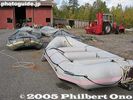
Rafts ready to roll from KäyläOct 05, 2005
|
|
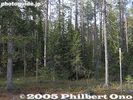
Frontier Zone forest borderThe border is marked by sticks in the ground having yellow rings.
森林の中にも国境をちゃんと表示している。Oct 05, 2005
|
|
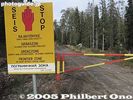
Border caution signOct 05, 2005
|
|
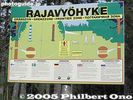
Frontier Zone noticeOct 05, 2005
|
|
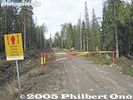
Russian border: Frontier Zone ロシアとの国境There were no border guards, but it is definitely not a good idea to cross into the Frontier Zone.Oct 05, 2005
|
|
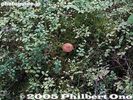
MushroomProbably not edible.Oct 05, 2005
|
|

Oct 05, 2005
|
|
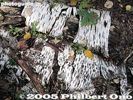
Old tree barkOct 05, 2005
|
|
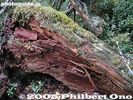
Growth on fallen treeOct 05, 2005
|
|

Fallen treeYou see fallen trees everywhere in the forest. Instead of being cleared away, they are left on the ground where they rot and host new life such as moss and lichens.
Finland has a lot of dead or half-dead trees too with wilted branches and no leaves. This is something we don't see so much in Japan. Most trees are cut down and hauled away for lumber before they die.
倒れた木が多い。そのまま放置されて後ほど新しい生き物が。Oct 05, 2005
|
|

Twisted tree ねじった木No one knows for sure how the tree trunk gets twisted like this. Maybe the snow twists it while melting around the tree.Oct 05, 2005
|
|
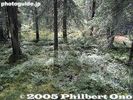
Forest floorOct 05, 2005
|
|

TreeOct 05, 2005
|
|
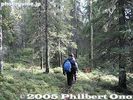
More forestOct 05, 2005
|
|
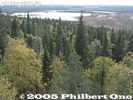
Yheksänsylenkallio scenic lookoutIt is above a tall cliff.Oct 05, 2005
|
|

Yheksänsylenkallio scenic lookoutAnother scenic lookout point on Näränkävaara Hill called Yheksänsylenkallio. Don't ask me how to pronounce it.Oct 05, 2005
|
|
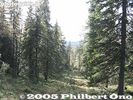
Forest boundary 古いと新しい森林の境Boundary between the old and new forest. Bird-watchers would love this area since there are many birds around.
Read more: http://www.kuusamobirds.net/en/tourism44.phpOct 05, 2005
|
|
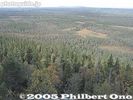
Kirkkokallio: Scenic lookout toward Russia ロシアA vast forest panorama unfolds from this lookout spot.
ロシアに向かっている素晴らしい景色。Oct 05, 2005
|
|
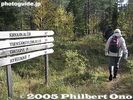
Trail to scenic spotsFrom the farm house, we hiked further up Näränkävaara Hill to the scenic lookout spots.
牧場からさらに歩くと景色のいいところがある。Oct 05, 2005
|
|
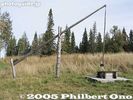
Not a wellOct 05, 2005
|
|

Bird houseAttached to the sauna building.Oct 05, 2005
|
|

Description of farm lifeIn Finnish, this describes the month-to-month, self-sufficient farm life here. Too bad there's no English translation.
毎月の牧場の生活を説明している(フィンランド語)。Oct 05, 2005
|
|
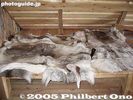
Mattress made of reindeer fur 敷き布団Looks soft and warm. How do they wash it?
敷き布団はトナカイの毛皮。Oct 05, 2005
|
|
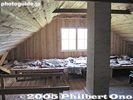
Farmhouse bedroom on 2nd floor 2階の寝室Bed for several people.Oct 05, 2005
|
|
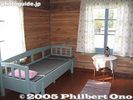
Farmhouse bedroomOct 05, 2005
|
|
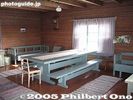
Farmhouse dining room ダイニングルームThe dining room is nice and spacious.Oct 05, 2005
|
|
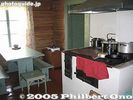
Farmhouse kitchen 台所Nice clean kitchen with wood-burning stove, and all the pots, pans, and utensils are provided.Oct 05, 2005
|
|
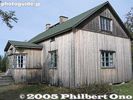
Farmhouse for rentSee the next image to see the inside.Oct 05, 2005
|
|
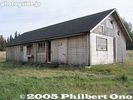
Old barn, now renovated 元牧場Näränkä farm's former barn has been renovated as an exhibition room. It had an old sled (pulled by horses) and farming tools on display.Oct 05, 2005
|
|
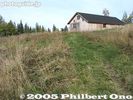
Näränkä farm 元牧場At the end of the trail, there was a small clearing on a small hill called Näränkävaara where there was a farmhouse and barn. It was the old Näränkä farm.Oct 05, 2005
|
|
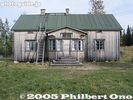
Näränkä farmhouse for rent 元牧場の家A farming family used to live here from 1841 to 1970. This was their house. The living conditions were quite severe during winter, but they were self-sufficient. The children had to walk for hours to attend school.
This house has been renovated and it is available for short-term rental. It can accommodate maybe 10-15 people. A sauna is also within the property. It's quite isolated so you have a lot of privacy.
For reservations and more info: http://www.kuusamobirds.net/en/tourism44.php
1841~1970年に農業の家族が住んでいた民家。この家は、リフォームされて短期間に貸し出し用。かなり大きいで10人以上が泊まれる。勿論、新婚さんも使用できる。サウナも別の建物にある。Oct 05, 2005
|
|

Näränkä TrailRubber boots were required for this easy hike first on these duckboards over the bog. After going to Finland, I found it difficult to understand the difference between marsh, swamp, wetland, and bog which I heard the most often in Finland. I usually call it marsh. Never used the word "bog" until I visited Finland.Oct 05, 2005
|
|

Reindeer rearNotice the owner's collar around its neck.
首輪に所有者の連絡先がある。Oct 05, 2005
|
|
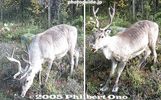
Boo! びっくりしたトナカイOn the way to Näränkä, we saw this reindeer feeding right along the roadside. It didn't notice us until some seconds later. That was enough to take out my camera and take photos. Finally, it saw us and got startled. The right photo shows the reindeer's surprised look on his face. This was the closest I ever came to a reindeer.
道端にいたトナカイがびっくりした。Oct 05, 2005
|
|

Näränkä map ナェラェンカェの地図Näränkä is southeast of Kuusamo near the Russian border (purple line on map). There's a hill called Närängänvaara from which there are scenic lookouts. It's an easy drive from Kuusamo if you know which way to go. The roads are unpaved.
Once Russia allows tourists in Finland to cross over to Russia, this area will probably become quite popular.
More info: http://www.luontoon.fi/Oct 05, 2005
|
|
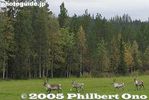
ReindeerOn the way to Julma Ölkky, we saw reindeer. They started running as soon as they saw us.
この地域では、トナカイとよく出会う。野生と見えるが、所有者がいる。首輪もあって所有者の連絡先が載っている。事故(例えば車と)があった場合に所有者に連絡できるようになっている。Oct 05, 2005
|
|
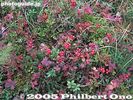
Edible berriesBut pretty sour.Oct 05, 2005
|
|
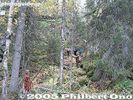
Hiking trailIt was very lush with forest, berries, mushrooms, and lichen.Oct 05, 2005
|
|
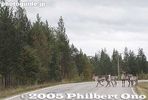
Reindeer crossingFor some reason, reindeer like to cross the road. Our guide gave out a reindeer call and they stopped for a moment to listen. We took their pictures and they ran off.Oct 05, 2005
|
|
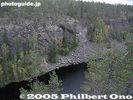
Top of canyonNice view from the ridge. Wish I had a wide-angle lens.Oct 05, 2005
|
|

Ahoy there!Our boat cruised around a bit while we went hiking. The rock walls rise as high as 50 meters from the lake's surface. This photo has been digitally composited.Oct 05, 2005
|
|
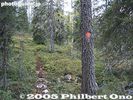
Orange spot marks the pathThese orange spots must really help when the ground is covered with snow.
木のオレンジのマークがハイキングコースの案内印。Oct 05, 2005
|
|
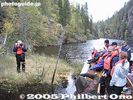
Lassi aloneHe tied a rope to the log and the boat dragged it away. Fortunately, he had a change of clothing. Amazingly, he never shivered and never complained. Such a great sport.Oct 05, 2005
|
|
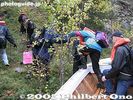
LandingWe got off the boat in the middle of the canyon and some of us went for a short hike to the top of the canyon.Oct 05, 2005
|
|

Our guide in the waterLassi, our fearless and dedicated nature guide, entered the frigid water to remove a log that was obstructing the boat landing where we were going to disembark for a short hike.Oct 05, 2005
|
|
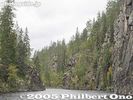
Canyon viewOct 05, 2005
|
|

Tree growing on solid rockOct 05, 2005
|
|
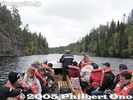
Scenic cruiseIt's not a very long cruise, but it was pleasant. Taking lunch and hot drinks was a good idea.Oct 05, 2005
|
|
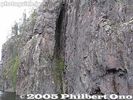
Devil's ChurchThis arch-shaped rock formation was called the Devil's Church by local inhabitants long ago.Oct 05, 2005
|
|
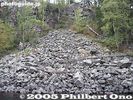
Oct 05, 2005
|
|
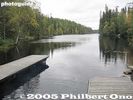
View from boat dockOct 05, 2005
|
|
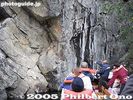
Ancient painting on stone wallOct 05, 2005
|
|
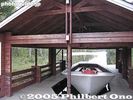
Boat dockFirst we all donned orange life jackets.Oct 05, 2005
|
|
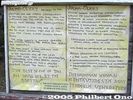
About Julma Ölkky ユルマ・オェルッキュについてGood introduction to the canyon lake.
石壁は最高50mの高さがある。湖の深さも50m位。一つの目玉は、石壁に書いている絵(4000年前)。Oct 05, 2005
|
|
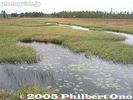
MarshWe saw a moose here, but it ran away. Like this place, Finland has a lot of wetlands. Rubber boot makers must do good business in this country.Oct 05, 2005
|
|
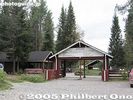
Julma Ölkky boat dockIt seems that only one operator offers boat trips in the canyon lake during summer.
Web site: http://www.julmaolkky.fi/Oct 05, 2005
|
|
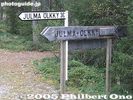
To Julma ÖlkkyAn easy day trip from Kuusamo, if you know how to get there. The road is unpaved.Oct 05, 2005
|
|

Manga display in bookstoreManga and anime have taken Europe by storm. It was surprising to see bookstores even in Finland having prominent displays of manga and anime books and magazines.
マンガとアニメがヨロッパにも大人気。まさか人口5百万人のフィンランドにも人気で本屋に行くと必ずこのようなマンガ/アニメのディスプレイが設置してある。Oct 05, 2005
|
|

Bus in front of Railway Station 駅前のバスFinnish design perhaps. Definitely better looking than buses in Japan.Oct 05, 2005
|
|

Railway Station platforms 駅のホームNever rode a train in Finland. Can't see it in this picture, but there was a fruit stand on the right.Oct 05, 2005
|
|

Inside a fortress building 中の石垣The fortress has a lot of nice stonework still intact.
スオメンリンナは、まだ石垣がたくさん残っている。Oct 05, 2005
|
|

Bicycles next to Railway Station 駅前の自転車You see this only during the warmer months.
放置自転車は見かけなかった。ママチャリも全然ない。Oct 05, 2005
|
|
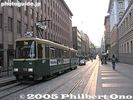
Tram in downtown HelsinkiTrams and buses are the city's main means of public transportation.
日本では市電が少なくなっていますが、ヨロッパではまだ健在。Oct 05, 2005
|
|
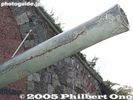
Closeup of cracked barrel 割れた砲Oct 05, 2005
|
|
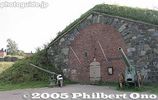
Japanese gun on left 沿岸砲兵博物館にてThe gun is in front of the Coastal Artillery Museum at Suomenlinna. You can find it on the "Guns of Suomenlinna" map available free at the Visitor Center.
左が元日本海軍の大砲。沿岸砲兵博物館の前にある。スオメンリンナの観光案内所で大砲の地図がある。それを見ればこの日本の砲も見つけられる。Oct 05, 2005
|
|
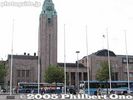
Helsinki Railway Station ヘリシンキ中央駅In Finnish, "Rautatieasema" (or "Rautatientori" for the railway square where the bus stops in front of the rail station). A good word to know when you want to catch a bus to the railway station. Compared to English (and Japanese), the Finnish language has many long words with so many syllables. I had much difficulty trying to pronounce and spell words in Finnish.
The terminal building was designed by Finnish architect Eliel Saarinen (1873-1950). Not to be confused with his famous son Eero Saarinen (1910-1961) also an architect who designed Dulles Airport near Washington, DC and the Gateway Arch in St. Louis, Missouri. (I didn't know he was Finnish.)
Even this side entrance of the train station looked so impressive that I thought it was the front side of the station. The front side is much wider and grander.
フィンランド出身の有名建築家エーロ・サーリネン(1910-1961)の父親、エリエル・サーリネン(1873-1950)が設計した中央駅。写っているのは、一つの横の入口で、正面側はもっと大きい。この横の入口でもりっぱなもの。Oct 05, 2005
|
|
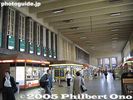
Railway Station terminal buildingThere are people, but it is never as crowded as a central train station in Japan.Oct 05, 2005
|
|
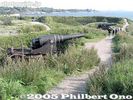
Suomenlinna fortress スオメンリンナComprising several small islands, Suomenlinna was a sea fortress originally built in 1748 by the Swedish empire (when Finland was part of Sweden) to fend off attack by Russia in the east.
Today, it is Helsinki's biggest tourist attraction. Besides being a World Heritage Site, it is a pleasant island for picnics (in warmer months) and picture-taking. It's quite big, so you cannot see everything on a day trip.
The fortress has museums, restaurants, and over 100 old cannons and guns still remaining.
Web site: suomenlinna.fi
Another: Virtual Finland
世界遺産でもあるスオメンリンナは、ヘルシンキ沖にある島で中世の城塞。ヘルシンキの最大の観光目玉。スオメンリンナはまだ100本以上の大砲が残っている。
HP: スオメンリンナ要塞(日本語)Oct 05, 2005
|
|

Maker's inscription on Japanese gun 大砲の日本語表示It says the gun was made by Kure Naval Arsenal in the 31st year of the Meiji Period (1898). Kure was a large naval base in Hiroshima Prefecture.
砲尾の上に「呉海軍造兵廠、明治参拾壱年」 が刻まれていた。Oct 05, 2005
|
|

Valiant service of Japanese gunThis plaque next to the gun describes how it fired its last shot during the Winter War on Feb. 19, 1940 despite being badly damaged. It destroyed a Russian tank and thus repelled a Russian battalion.
Taipale was a small Finnish town on the northwestern shore of Lake Ladoga which is now part of Russia. It was one of Finland's front-line defenses against the advancing Soviet army. Although Taipale never fell to the Russians, it was later ceded to Russia along with the entire surrounding area in accordance with a peace treaty.Oct 05, 2005
|
|

Serial No. on Japanese gunThis looks like a serial No. for this gun. It reads 2143.
砲の製造番号と思われる「弐千百四拾参基」と刻んでいる。Oct 05, 2005
|
|
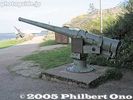
Japanese gun at Suomenlinna 明治時代の日本海軍の大砲We were surprised to hear that Suomenlinna had a cannon from Japan. The Suomenlinna Visitor Center had a map in English called "The Guns of Suomenlinna" with all the cannons and guns listed (over 100), including the Japanese gun.
However, there was no explanation of the Japanese gun, and no one at the Visitor Center knew the history behind the Japanese gun. And I could not find any books in the Visitor Center gift shop that explained about the gun, like how in the world it got to Finland and Suomenlinna from faraway Japan.
But after returning to Japan, I did some reading and found out interesting things about it. On the Web, I found a few Japanese sites (but none in English) that mention this gun, and I found only one Web site with a picture of the gun. So I'm happy to show better pictures of the gun as well as an explanation in English.
This is what I found out so far:
The gun was made at Kure Naval Arsenal in Hiroshima Prefecture in 1898. (This can be confirmed by the inscription on the gun.) Kure was a major navy base.
After the Russo-Japanese War in 1904-05, Japan exported this gun to Russia. Before World War I broke out in 1914, Russia placed this 120mm-caliber gun on the coast to help defend the Gulf of Finland and St. Petersburg (or Petrograd as it was known during WWI) from possible attack by Germany. (Finland during this time was part of the Russian empire.)
After the Russian Bolshevik Revolution of 1917, Finland seized the opportunity and declared itself as an independent country which was approved by Russia. It thereby inherited this Japanese gun positioned in the former Russian territory now under Finnish control. For coastal defense, Finland used this gun as left by the Russians.
On Nov. 30, 1939, the Soviet Union attacked Finland with the intent to conquer it by the end of the year and make it a buffer state against hostile Nazi Germany. This started the Winter War with Finland which lasted until March 1940.
Although Finland's forces were greatly outnumbered by the Soviets, their guerrilla tactics and the severe winter inflicted heavy Soviet casualties. One major battlefront was near a small Finnish town called Taipale on the northwestern shore of Lake Ladoga near St. Petersburg. Taipale had two Finnish batteries, one of which was at Järisevä on the lakeshore, where the Japanese gun was stationed. (I'm not sure how the gun got to Taipale, whether the Russians had put it there from the beginning or whether the Finns moved it there from Finland's coast.)
Taipale was not too far from the border with the Soviet Union and was at the mouth of a small river called Taipaleenjoki. By Dec. 6, the Soviets from the southwest advanced far enough to reach the river on the side opposite of Taipale. What looked to be a piece of cake for the Soviets turned out to be a bloody battle lasting 3 months. The Finns proved to be ferocious fighters.
By Feb. 19, 1940, the Soviets finally started to make headway into the Finnish line of defense, called the Mannerheim Line that partially straddled along the Taipaleenjoki River, with heavy air and ground attacks. It was also the day when they attacked Taipale from both the east and west.
The west flank faced the ice on Lake Lagoda over which the Soviets marched, only to meet with artillery fire from the Järisevä battery on the lake shore. With the help of the damaged Japanese gun, the Finns destroyed two Soviet tanks and kept firing until they ran out of ammunition. The Soviet attack on Taipale from the west thus ended in failure, and the attack from the eastern flank was also futile. The lake ice was littered with dead Soviet soldiers. At the end of the war, the Finns carried their beloved Japanese gun back to Finnish territory even though it was damaged beyond repair.
Although Taipale never fell to the Soviets during battle, Finland was forced to cede the town and the entire region around northern Lake Ladoga (plus some territory in northeast Finland) to the Soviets in accordance with the Moscow Peace Treaty that ended the Winter War on March 12, 1940. These concessions understandably upset many Finns. Thousands of Finnish lives had been lost fighting for territory that was later handed over to the Soviets in peace. The ceded area was also Finland's industrial center and cradle of Finnish (Karelian) culture. The peace lasted only for about a year until both countries again fought each other during the Continuation War during June 1941 to September 1944.
Here's a little more background info about the gun researched by my friend Ronny Rönnqvist and edited by me:
Specifications
The gun is a derivative of the British 4.7 inch/40 (120mm/12cm) Amstrong-Elswick Naval/Coastal Gun, developed in the 1880s. The gun was manufactured under license in Japan by the Kure Naval Arsenal and used on Japanese cruisers of the late 1800s / early 1900s and later as a coastal defence gun.
In Japan the gun is known as Meiji 31st Year Type (120/41A) Kaigun Ho. (As inscribed on the gun in Japanese.) Some guns might have been taken by the Russians already during the Russo-Japanese war, but Japan also later on sold a quantity of these guns to Russia.
History
This particular gun in Suomenlinna is very famous in Finland. It belonged to 8 guns of this type left by the Russian Army in Finland after the War of liberation in 1917-18 when Finland won its independence. These guns were then used as coastal defence guns in various locations.
During the final days of the Winter War in 1940, the Fort of Järisevä in the Finnish town of Taipale on the western shore of Lake Ladoga (now in Russian territory near St. Petersburg) was defended by two such guns. In February only this gun was working when a Russian batallion approached over the lake ice on Feb. 19, 1940.
The gun had been hit and damaged (see the crack on the side of the barrel), but could be barely repaired in time in order to fire at the approaching enemy. By direct aiming and firing the gun with a hammer and although the barrel was badly damaged, the crew succeeded in hitting the tank leading the attack by the 6th shot. Thereby the Russian battalion withdrew and Taipale was saved.
The gun therefore became very famous and was taken to Finland and eventually moved to Suomenlinna to have a place of honour in front of the Coastal Artillery Museum where it is located today.
There were many more Japanese guns used by Finland, all left by the Russian Army in 1918:
- 75 mm mountain gun type 75 VK 98
- light 47mm coastal gun type 47/30
- heavy 150 mm hoowitzer type 150H 14 J ( J for Japan ! )
- a large quantity of Arisaka rifles
But none got as famous as this gun at Suomenlinna!
スオメンリンナには、なんと明治時代の日本海軍の大砲も設置してありました。日本からロシアへ輸出されたそうです。そしてロシアから独立国になって大砲がそのままフィンランドのものになった。
1939-40年のソ連との冬戦争中にラゴダ湖岸にあるタイパレ村にフィンランド軍がこの痛んだ大砲でソ連の部隊に発砲して一台の戦車を大破してソ連の攻撃が失敗に終わった。これで一躍有名になった大砲がスオメンリンナの栄誉な場所に移動された。ロシアから譲った他の日本製の砲もあったそうですが、この砲が一番歴史的で有名。Oct 05, 2005
|
|

Helsinki waterfront market place and seagull マーケット広場The waterfront and market square is one of the city's most picturesque areas.
ヘルシンキ市内の一番美しいところ。Oct 05, 2005
|
|
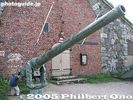
Japanese gun at Suomenlinna 日本海軍製の大砲Right view of gun where you can see the cracked barrel.Oct 05, 2005
|
|
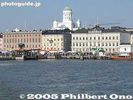
Helsinki waterfront from ferryThe Cathedral floats nicely above the waterfront buildings. Now I understand why it was built on a hill and painted white.
白い大聖堂も浮かぶように見える。Oct 05, 2005
|
|
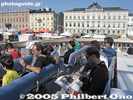
Ferry to Suomenlinna Sea Fortress スオメンリンナへのフェリーA boat for Suomenlinna departs often from the market place at the waterfront. Only 15-min. ride. Suomenlinna is a sea fortress designated as a World Heritage Site and Helsinki's biggest tourist attraction.
スオメンリンナは、ヘルシンキ沖にある島で中世の城塞。このフェリーで15分。
HP: スオメンリンナ要塞(日本語)Oct 05, 2005
|
|
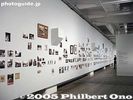
Finnish Museum of Photography フィンランド写真美術館の展示室Large, impressive space. The bookshop also had a good collection of photo books.
相当広いスペースです。一階だけですが、いくつかの展示部屋が仕切っていた。Oct 05, 2005
|
|
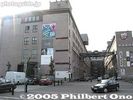
Finnish Museum of Photography フィンランド写真美術館It is in a complex called the Cable Factory since it used to be a cable factory. The photo museum is housed in the large building on the left. The museum even once held a Japanese photography exhibition in 2001 which had traveled from Sweden. They still had the exhibition catalog in stock so I bought one.
The complex also houses other cultural facilities like dance theaters and art galleries.
Web site: fmp.fi
元のケーブル生産工場が現在美術・文化施設となっている。2001年にスウェーデンから来た日本の写真展も開催された。その図録が館内のショップでまだ販売されて一冊買った。Oct 05, 2005
|
|
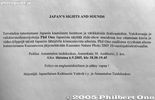
Slide show notice スライドショーのお知らせPosted in Annantalo for my slide show held on September 6, 2005, from 6:30 pm to 7:45 pm. The slide show was titled "Japan's Sights and Sounds" to show my pictures and movie clips of Japanese festivals. It was planned almost at the last minute. A small announcement also appeared in Helsinki's leading newspaper called "Helsingin Sanomat (English version)."
フィンランド語のスライドショーお知らせ。会場内の掲示板にて。Oct 05, 2005
|
|

Slide show in Annantalo auditorium スライドショーFor about 80 min., I showed my pictures and movie clips of Japanese festivals in English: Kiba Kakunori square log rolling, Tokyo Jidai Festival, Yamato Awa Odori Dance, Onbashira Festival in Nagano, Yotsukaido Hadaka (Mud) Festival, Yokaichi Giant Kite Festival in Shiga Pref., Imperial Palace visit on the Emperor's Birthday, and more.
The slide show was held as an event by the Friends of Japanese Culture Society in Helsinki. It was a good crowd, perhaps 30 or more people attended. Special thanks to the Society's chairman, Ronny Rönnqvist, who arranged everything on very short notice, and to the Annantalo staff. Annantalo is also the venue used by the Society for its annual Japan Day event in April.
Annantalo Web site: kulttuuri.hel.fi/annantalo/esittely_en.html
80分ほど日本のお祭りをスライドショーで英語で紹介しました。木場角乗り、東京時代祭り、大和市の阿波踊り、滋賀県八日市大凧祭り、皇居の一般参賀など。約30人が来場した。ヘリシンキにある「フィンランド・日本文化友の会」のイベントとして開催されました。その会長(Ronny Rönnqvist)が私の友人でお世話になりました。
偶然に一ヶ月前にこの会長が別件で初めてメールが来て、返事のついでに「実は、9月にフィンランドへ行くよ」と言ったら「是非会いましょう」と。じゃ、せっかくだから、友の会のためにもスライドショーやってあげようかと提案したら急きょ受け入れてくれた。クーサモへ行く前にヘルシンキに数日間いる予定だったのでヘルシンキにも日本を紹介できました。運良くこのいい会場が見つかれた。Oct 05, 2005
|
|

Friends of Japanese Culture Society officeThe office is actually a small room in this nice building.
Web site: japaninkulttuuri.net
「フィンランド・日本文化友の会」の事務所があるビル。Oct 05, 2005
|
|
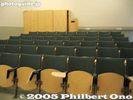
Annantalo auditorium 小ホールの中Nice little venue for my slide show in Helsinki. It seats 45 people.
45席の小さいホールが会場。Oct 05, 2005
|
|
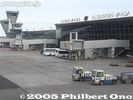
Helsinki-Vantaa Airport ヘルシンキ・ヴァンター空港It takes about 9 to 9 1/2 hours from Tokyo to Helsinki via Finnair. Only one country lies between Japan and Finland: Russia. Both countries actually share a border with Russia. As of this writing, Finnair flies direct from Tokyo only twice a week. Narita is so congested with only two runways, they cannot offer more flights. Finnair has more direct flights from Kansai Airport in Osaka.
現在では、成田発のヘルシンキへの直行便は週に2便しかない。関空発は週に5便。9時間ちょっとでヘルシンキへ行ける。Oct 05, 2005
|
|
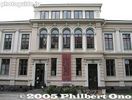
Annantalo Arts Centre (my slide show venue) スライドショーの会場A former primary school built in 1886, this distinguished-looking building is now an arts center for children and young people. It also has a small auditorium where I gave a slide show on Japanese festivals on Sept. 6, 2005. It's centrally located and convenient.
Annantalo Web site: kulttuuri.hel.fi/annantalo/esittely_en.html
ヘルシンキにも急遽スライドショーをやることになってこの会場になりました。児童の芸術文化センターの施設。市内の中心部にある。Oct 05, 2005
|
|
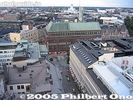
View from Sokos Hotel Torni ホテルの展望台Helsinki has no real tall buildings so the skyline is low. In this picture, you can see the famous white cathedral in the background and Stockmann department store (brown building) in the foreground.
Helsinki also has many islands off shore. Helsinki's sister city in Japan is Sendai in Miyagi Prefecture. It's easy to guess why. Sendai is also a coastal city and near Matsushima, famous for many pine tree islands in the bay.
This terrace atop the Sokos Hotel Torni afforded a terrific, 360-degree panoramic view of Helsinki. The terrace also has chairs and tables since it is part of Ateljee Bar.
ヘリシンキは、高層ビルがなくて低いスカイラインである。海岸沿いに島々が多い。ちなみに仙台市と姉妹都市でもある。Oct 05, 2005
|
|
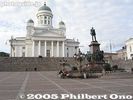
Senate Square and Cathedral ヘリシンキ大聖堂One of the symbols of the city, called Tuomiokirkko. This Lutheran church was completed in 1852.
More Helsinki sights: Helsinki City Tourist & Convention Bureau
ヘリシンキの一つのシンボルである。中は割りと地味な感じ。
HP: フィンランド政府観光局(日本語)Oct 05, 2005
|
|
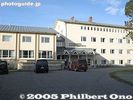
Kuusamon Kansanopisto 宿泊先This is where most of us stayed in Kuusamo during the nature photo festival. It was almost right across the street from Kuusamo Hall, making it very convenient and economical. It's near a supermarket and restaurants. It's like a hostel with communal showers, toilets, and kitchen. Breakfast was good too. Normally open during summer.
Web site: http://edu.kuusamo.fi/kansanopisto/
クーサモの宿。外国から来た写真祭りの参加者はほとんどここに泊まった。とても便利な所でした。シングル部屋もあるけど、シャワーとトイレは共有。夏樹だけ営業。安い。Oct 05, 2005
|
|

Shower, toilet, and rubber broom シャワーとトイレThe floor of the shower area is the same as the toilet's. After taking a shower, we have to use a rubber broom (upper right corner) to sweep the water to the drain. I still don't understand why we have to do this and why the shower does not have a separate floor. Apparently this is common in Finland especially in older buildings.
シャワーとトイレの床は共有でシャワーの後にゴムぞうきん(右上)で水を排水に。面倒と思うけど、フィンランドの古い家にこうなっている。Oct 05, 2005
|
|

Birds of Hokkaido, by Tadashi Shimada (クーサモ図書館への寄贈図書)Great collection of various birds photographed in Hokkaido, Japan's northern-most island. See book review here.
This book has been donated to the Kuusamo public library by Philbert Ono.
この写真集もPhotoGuide Japanがクーサモ町の図書館へ寄贈しました。Oct 05, 2005
|
|

Manga display in Kuusamo bookstore クーサモにもマンガApparently, manga (comics from Japan) is popular even in Kuusamo. In English, we call this character Astro Boy. In Japanese, "Tetsuwan Atom."
クーサモの本屋さんにもマンガあり。Oct 05, 2005
|
|

Fukei Shashin (Landscape Photo) magazine (クーサモ図書館への寄贈図書)This is a magazine dedicated to landscape and nature photography in Japan. It is published every two months.
This July/Aug. 2005 issue has been donated to the Kuusamo public library by Philbert Ono.
この雑誌もPhotoGuide Japanがクーサモ町の図書館へ寄贈しました。Oct 05, 2005
|
|
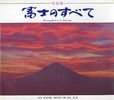
All Scenic Spots of Mt. Fuji, by T. Watanabe (クーサモ図書館への寄贈図書)Mt. Fuji is of course Japan's symbol and most beautiful mountain. It is a favorite subject among many photographers because it affords an infinite variety of angles and views from which you can photograph it. Not to mention the different times of day and the different seasons when you can capture the mountain. Of course, you can also climb it.
This little book contains an excellent variety of beautiful Mt. Fuji photos.
This book has been donated to the Kuusamo public library by Philbert Ono.
この写真集もPhotoGuide Japanがクーサモ町の図書館へ寄贈しました。Oct 05, 2005
|
|
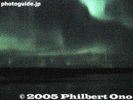
Aurora over the lake オーロラと湖Seeing the aurora in the sky and reflected on the lake was simply awesome.
湖に反映されて奇麗だった。なにも音もしない。形が常に変わる。Oct 05, 2005
|
|

Shiki no Shashin (Four Seasons Photo) magazine (クーサモ図書館への寄贈図書)This is a magazine dedicated to nature photography in Japan. It is published every two months.
This Aug./Sept. 2005 issue has been donated to the Kuusamo public library by Philbert Ono.
この雑誌もPhotoGuide Japanがクーサモ町の図書館へ寄贈しました。Oct 05, 2005
|
|

Northland Japanese Cranes, by Masahiro Wada (クーサモ図書館への寄贈図書)Beautiful pictures of this favorite bird of Japan in very scenic locations, mainly Hokkaido. In Japanese, this bird is called "tancho." See book review here.
This book has been donated to the Kuusamo public library by Philbert Ono.
この写真集もPhotoGuide Japanがクーサモ町の図書館へ寄贈しました。Oct 05, 2005
|
|
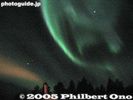
Aurora! オーロラ!We were very lucky to see the northern lights that evening too. September is usually still too early for the northern lights to appear, but there it was.
It was a greenish veil of light floating in the black sky and ever-changing in shape. It doesn't make any sound. It was my first time to see northern lights. In Finnish, they call it "fox tail."
The orange stream on the lower left is actually steam (or smoke) coming out of the sauna tent. It's not part of the aurora. I don't think I could've taken this picture with a film camera. It was too dark.
オーロラも見えて超ラッキー!ちょっと早い時期だけど、珍しく現れた。Oct 05, 2005
|
|
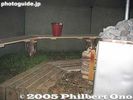
Inside Finnish sauna サウナの中This is what it looked like (before we all entered stark naked).Oct 05, 2005
|
|

Invisible Power, by blind photographers (クーサモ図書館への寄贈図書)I showed some pages in this book during my 2nd slide show in Kuusamo. The pictures in the book were taken by blind photographers. It includes a few pictures which are embossed so that the blind can touch and feel the pictures. This book has been donated to the Kuusamo public library by Philbert Ono.
この写真集もPhotoGuide Japanがクーサモ町の図書館へ寄贈しました。
Here is my book review:
For most of us, going blind is one of our worst fears. Especially for a photographer. After all, how can you take pictures and look at pictures if you're blind?
Ask a blind photographer to answer such questions. Yes, there are blind photographers. How do they do it? Well, imagine how you would take pictures if you were blind. First, your ears would serve as a guide. By listening carefully, you can tell where the subject is and how far away. If you want to photograph a person, take the picture when you hear laughter. Your ears can serve well as a guide to when to take the shot.
For still-life subjects, you can touch the object (flowers, etc.) and decide which angle to photograph it from. If you're waiting for a sunrise, feel the heat of the sun on your skin before taking the picture. You can also discern which direction the sun is in. Besides using your other four senses, a major boon is having a seeing person tell you what's going on and when to take the picture.
And that's how they do it. It's truly amazing how adaptive and strong humans can be to overcome any kind of handicap. The same applies to the blind. In Tokyo, sometimes I see a blind person taking a subway or train. You know how difficult it is even for seeing people to navigate through all those crowds in the train/subway stations? There are pimpled tiles on the ground to guide the blind, but still, the blind are truly awesome to venture out by themselves. It is the "unseen or invisible power." Of course, we all have it, but most of us don't really know how to tap into it.
As for the question of how a blind person can "see" photographs, this book gives the answer. Besides regular color photographs, it includes nine pictures that you can touch and feel. They are embossed images (that smell like rubber), and each one is captioned in Braille. The book claims to be the first photo book in Japan to include such images for the blind. All the pictures are of typical subjects that most amateurs in Japan pursue: Mt. Fuji, cherry blossoms, festivals, flowers, family and friends, children, and even fireworks. You can't help but be impressed by the quality of the photos while knowing that they were all taken by a blind person.
The book says that photography by blind people started with the invention of fully automatic cameras and embossed printing technology. There is a special copying machine (rittai kopii-ki) that can produce an embossed image of the copied photograph.
The photographs in the book come from the best ones that have been shown at the annual blind photographers exhibition held annually in the past 15 years in Tokyo. The common reaction of most visitors to these exhibitions is, "Blind people taking pictures? I don't believe it!" Their disbelief soon turns into admiration, and the common notion that blind people cannot take pictures is totally dispelled. Such is the power of the blind, not only in being able to take pictures, but in also affecting normal seeing people in positive ways.
The National Blind Photographers Exhibition (Zenkoku Mojin Shashin-ten) was first held in 1985 in Tokyo. Over 200 pictures by blind people all over Japan are submitted and a panel of judges select about 60 pictures for the exhibition held every Dec. in Shinjuku, Tokyo. The exhibition displays each photograph in two ways. There's the normal photograph, and then there's an embossed version (made by the special copying machine) of the same picture that the blind can touch and feel with their fingers.
The exhibition is not only about the photographs themselves, but also about the determination and effort by the blind and the loving support of family members. It's about the people behind the camera and about tapping that "power" that lies within (usually dormant for most of us). The exhibition is supported by corporations (like Minolta which developed the special copying machine), organizations, and prominent pro photographers. The honorary chairman of the panel of judges is Prince Mikasa, a relative of the Emperor. Personally, I think it's just fantastic that blind people are able to take pictures and look at them. Having a means of self-expression is so important to all humans. (Reviewed by Philbert Ono)Oct 05, 2005
|
|

Photo books from Japan donated to Kuusamo Public Library. 日本からの写真集を現地の図書館へ寄贈。This was our backstage lounge at Kuusamo Hall. Before donating a bunch of Japanese nature photo books to the Kuusamo public library, I left them in this lounge where the other participating photographers could look at them during slide show breaks. Three of the books (and one DVD) were donated by the three photographers I introduced in my third slide show. The rest were bought and donated by me. The images following show what books I donated.
日本から持ってきた写真集をホールの控室に置いて他の参加者の写真家が拝見した。写真祭りが終わってからこれらの写真集をすべてクーサモ町の図書館へ寄贈しました。Oct 05, 2005
|
|
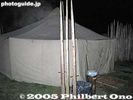
Finnish sauna tent サウナOn September 10, they took us all to dinner to a place near a lake. After dinner (reindeer meat), we went to this sauna in a large tent.
食後にサウナへ。Oct 05, 2005
|
|
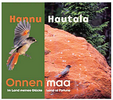
New book by Hannu Hautala, "Onnen maa" (Land of Fortune) ハンヌ・ハウタラの新写真集Cover of his new book published in Oct. 2005. The text is in Finnish, English, and German.
Sample photos and order at Articmedia.Oct 05, 2005
|
|

Path to lake サウナの後は冷たい湖へA Finnish sauna is always near a lake. After the sauna, you supposed to take a dip in the freezing lake. I went to the lake but declined to go in.
湖に入りませんでした。Oct 05, 2005
|
|

Inside Finnish sauna サウナの中It got very foggy inside as they kept splashing water on the hot rocks. It didn't get very hot, but it was interesting. Lots of steam and only a single light illuminated inside the sauna.
蒸気で中ではなにも見えなくなった。見えないけど皆は全裸。Oct 05, 2005
|
|
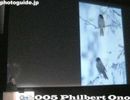
Slide show by Hannu Hautala ハンヌ・ハウタラ氏He showed pictures from his upcoming photo book, "Onnen maa" (Land of Fortune) to be published in Oct. 2005 (see next image).
新しい写真集を紹介した。Oct 05, 2005
|
|

Kuusamo newspaper "Koillis sanomat" 地元の新聞Since it was one of the sponsors, the local newspaper wrote about the nature photo festival daily. I even got interviewed for a story. They asked me questions like how they can attract more Japanese tourists to Kuusamo. I replied that we need more direct flights from Tokyo to Helsinki. (There are only two a week via Finnair as of this writing.)
一つのスポンサーである地元の新聞紙もこの写真まつりを大きく取り上げてくれました。私のインタービューも掲載された。Oct 05, 2005
|
|

Bird with firey eyes, by Rob Jordan ロブ・ジョーダン氏Yes, that's firey, not fiery. This bird has bright red eyes and also bright feather strands emanating from the eyes, making it look like fire. Rob's photo was also used on the program booklet (see next image). He is from the UK.
Web site: robjordan.co.uk
この鳥の目が真っ赤で目の周りも炎と見える羽がある。プログラムの表紙写真にもなった(次の写真を参考)。Oct 05, 2005
|
|
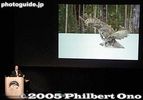
Slide show さまざまなスライドショーOver 30 nature photographers, both men and women, from eight countries gave slide shows during two consecutive weekends in September 2005. It was a great pleasure meeting the photographers and making new friends. Photos of birds were very popular, but there were also photos of the aurora borealis, Arctic landscapes, bats, and even live music.
8カ国から30人以上のネイチャーフォト写真家が集まりまして素晴らしいイベントでした。野鳥の写真が多かったけど、他にも北欧らしいオーロラの写真や北極地方の風景と野生生物の写真も発表された。Oct 05, 2005
|
|
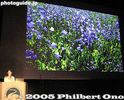
Slide show by Estonian photographers エストニア人のスライドショーThe evening of September 12 was devoted to works by six Estonian photographers. Pictured is woman photographer Kaari Saarma.
The Estonian night climaxed with Tõnu Ling's live harmonica performance during an automated slide show of his beautiful pictures of his native Saaremaa and Muhumaa islands in Estonia.
6人のエストニア人の写真家がスライドショーをやりました。一人は女性。とてもフレンドリーな連中でした。エストニアは、ヘルシンキから簡単に行ける国。Oct 05, 2005
|
|
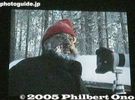
Film of Hannu Hautala ハンヌ・ハウタラ氏On Friday September 16, it was Hannu Hautala night. It started with a film of Hannu at work in the wilderness. The film was beautifully accompanied by Heikki Sarmanto whose piano-playing reacted spontaneously to the film as he watched it.
ハンヌ・ハウタラ氏は、フィンランドの一番有名なネィチャー写真家。クーサモ在住。まず、ハウタラ氏の仕事ぶりを紹介する短い映画が上映した。BGMはライブのピアノ。Oct 05, 2005
|
|
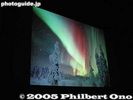
Northern lights slide show by Jorma Luhta オーロラの写真What would a nature photo festival in Finland be without photos of the aurora borealis? Wisely, they included some northern lights pictures. This Finnish photographer showed spectacular images of northern lights. Looks really surreal or like in a dream. Wish there was an English translation of his Finnish narration.
Web site: Jorma Luhta
とても美しいオーロラの写真もフィンランド人の写真家が紹介した。Oct 05, 2005
|
|
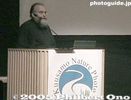
Hannu Hautala ハンヌ・ハウタラ氏Hannu Hautala speaks.
ハウタラ氏の出番。Oct 05, 2005
|
|
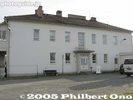
Venue for exhibition by Estonian photographers エストニア人の写真展Besides Kuusamo Hall, other venues in Kuusamo were used for exhibitions like this one called Porkkatörmä. It has exhibition rooms on the first floor where Estonian photographers exhibited their works. The 2nd floor had a small museum introducing Kuusamo's local history.
別の会場でエストニア人の写真展が開催された。エストニアは、フィンランドの隣国と言える直ぐそばの国。ヘルシンキからフェリーで簡単に行ける。Oct 05, 2005
|
|

Book by Satoshi Kuribayashi (寄贈図書)Some of the pictures by Satoshi Kuribayashi which I showed in the slide show came from this award-winning book titled "The World of Kuribayashi Satoshi." See book review here.
This book has been donated to the Kuusamo public library by Satoshi Kuribayashi as recommended by Philbert Ono.
ISBN: 4054012507
上映した写真は、この写真集からも選びました。私の推薦で栗林先生がこの写真集をクーサモ町の図書館へ寄贈しました。Oct 05, 2005
|
|

Sept. 11, 2005: The third photographer I introduced was insect photographer Satoshi Kuribayashi who lives in Nagasaki Prefecture. He is an award-winning photographer who has published numerous photo books in Japan. 僕のスライドショーその3The third photographer I introduced was insect photographer Satoshi Kuribayashi who lives in Nagasaki Prefecture. He is an award-winning photographer who has published numerous photo books for the public and children in Japan.
I knew that insect photography was not so popular in Finland, but I believed that this photographer's work and technique would be very interesting to people in Finland, so I asked him to send some pictures and books to me. He happily obliged.
As I expected, his pictures (and DVD movie) were very well received by the audience in Kuusamo. First I showed some of his extreme closeup pictures of insects, then a few pictures of his custom-made cameras and him at work (as you see here). For the remaining 9 minutes of the slide show, I showed his fantastic DVD movie of insects.
Sample photos:
Migratory locust
Melon fly
Camponotus japonicus ant
Tiger beetle
Beetle in flight
His Web site: http://www5.ocn.ne.jp/~kuriken/
最後に、栗林 慧先生の昆虫写真作品と興味深い手作りのカメラやその仕事ぶりを紹介してDVDの動画も一部上映しました。これもとても好評でした。北欧では昆虫写真はあまり人気ではないが、栗林先生の作品を見たら皆さんの関心が集めました。予想とおりでした。やはり昆虫も面白い。Oct 05, 2005
|
|
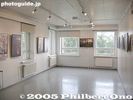
Exhibition by Estonian photographers エストニア人の写真展In this room at Porkkatörmä gallery, pictures by Tõnu Ling and Tan Silliskaar.Oct 05, 2005
|
|

Book by Satoshi KuribayashiThis book explains some of his shooting techniques and custom-made cameras. Notice his self-portrait with a real praying mantis. The book's title is, "The Cameraman Who Became an Ant."
こので栗林先生が手作りのカメラや撮影方法を紹介して参考になった。Oct 05, 2005
|
|

DVD by Satoshi Kuribayashi (寄贈図書)During the slide show, I showed about 9 min. of this 18-min. DVD movie showing super closeups of various insects eating, fighting, or killing (another insect). Everyone thought it was quite amazing. See DVD review here.
This DVD has been donated to the Kuusamo public library by Satoshi Kuribayashi as recommended by Philbert Ono.
Sample clips (Quicktime):
Locust eating
Praying mantis
スライドショー中にこのDVDの動画も一部上映しました。これもとても好評でした。
私の推薦で栗林先生がこのDVDをクーサモ町の図書館へ寄贈しました。Oct 05, 2005
|
|

Sept. 11, 2005: My third slide show introduced the works of three famous Japanese nature photographers. I devoted about 20 min. to each photographer. 僕のスライドショーその3My third slide show introduced the works of three famous Japanese nature photographers. I devoted about 20 min. to each photographer.
The first one was Mitsuhiko Imamori who takes pictures of Lake Biwa in Shiga Prefecture where he lives. Since Finland has so many lakes, I wanted to show pictures of Japan's largest lake called Lake Biwa. I showed pictures from his photo book titled "Water's Edge."
I explained about how the lake was not just a container of water. It was actually very dynamic with the warm and cold water constantly circulating inside the lake. Many rivers and streams also are connected to the lake, which in turn supports much nature and wildlife in and around the lake nicknamed "Mother Lake." Imamori also focuses on how people co-exist with nature and respect it.
Web site: imamori-world.jp
3回目のスライドショーは、いよいよ3人の有名日本人写真家(今森光彦、中村郁夫、栗林慧)の作品を紹介しました。最初は今森先生で、「水辺」という写真集から二十数点の写真を上映しながら琵琶湖を紹介して 「生きている湖」、「里山」などの話をしました。フィンランドは、湖がとても多い国で日本の代表的な湖も紹介したかったのです。Oct 05, 2005
|
|

Sept. 11, 2005: The second photographer I introduced was Ikuo Nakamura, one of Japan's most well-known underwater photographers. I explained about how soil erosion and runoff killed a lot of coral in Okinawa together with the starfish... 僕のス�The second photographer I introduced was Ikuo Nakamura, one of Japan's most well-known underwater photographers. I explained about how soil erosion and runoff killed a lot of coral in Okinawa together with the starfish, a natural enemy of coral. Then I showed 20 of his pictures of coral and marine life in Okinawa.
It was an automatic slide show with Hawaiian music in the background. (A lot of people liked the Hawaiian music which was by Kealii Reichel, a very famous singer in Hawaii.) This was the only slide show of underwater photos at the Kuusamo Nature Photo festival.
Web site: squall.co.jp
次に中村郁夫先生の沖縄の美しい水中写真を20点上映して、珊瑚礁の絶滅とか天敵などの説明をして作品をBGMと一緒に自動スライドショーを。(BGMには、沖縄の音楽にしたかったけど、それが忘れまして手元にあったハワイの曲にしました。そのハワイの曲もとても好評でした。)北欧に見れない熱帯の生き物を見せたくて写真祭りの唯一の水中写真のスライドショーでした。Oct 05, 2005
|
|
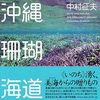
Book by Ikuo Nakamura (寄贈図書)The pictures by Ikuo Nakamura which I showed in the slide show came from this book titled "The Coral way Around Okinawa Islands." See book review here.
This book has been donated to the Kuusamo public library by Ikuo Nakamura as recommended by Philbert Ono.
ISBN: 4757207824
上映した中村郁夫先生の作品はこの写真集のものでした。私の推薦で中村先生がこの写真集をクーサモ町の図書館へ寄贈しました。Oct 05, 2005
|
|
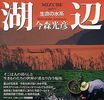
The first one was Mitsuhiko Imamori who takes pictures of Lake Biwa in Shiga Prefecture where he lives. Since Finland has so many lakes, I wanted to show pictures of Japan's largest lake called Lake Biwa.(寄贈図�The pictures by Mitsuhiko Imamori which I showed in the slide show came from this book titled "Mizube" (Water's Edge). See book review here.
This book has been donated to the Kuusamo public library by Mitsuhiko Imamori as recommended by Philbert Ono.
ISBN: 4418049118
今森光彦先生のスライド作品は、この写真集から使用しました。私の推薦で今森先生がこの写真集をクーサモ町の図書館へ寄贈しました。Oct 05, 2005
|
|
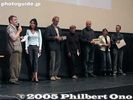
Kuusamo Nature Photo contest winners フォトコンの授賞式Lassi speaks with the winners of the nature photo contest. It's good to see both men and women photographers.
最優秀の作品は女性のアマでした。Oct 05, 2005
|
|

Sept. 10, 2005: My second slide show was titled, "Nature Photography in Japan." It was a mixed bag of slides introducing a very basic history of landscape photography in Japan, photo galleries in Japan, and nature photo books and magazines... My second slide show was titled, "Nature Photography in Japan." It was a mixed bag of slides introducing a very basic history of landscape photography in Japan, photo galleries in Japan, and nature photo books and magazines in Japan (with a closeup on a book called Invisible Power by blind photographers in Japan).
With the slide pictured here (of Kameido Tenjin Shrine's wisterias in Tokyo), I was giving an example of how early Japanese landscape photographers were influenced by woodblock prints. They tried to photograph the scenes and compositions made famous by woodblock artists such as Hokusai and Hiroshige.
2回目のスライドショーは、日本の写真史、自然と宗教(神道)との関係や写真集・雑誌など写真業界を紹介しました。このスライドは、初期の日本人風景写真家が北斎などの浮世絵から影響を受けたことを説明している。Oct 05, 2005
|
|
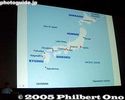
Sept. 9, 2005: My first slide show. For my first slide show, titled "Nature in Japan," I gave a basic introduction to Japan (first with a map shown here), and showed my pictures of mountains (Mt. Fuji, Kamikochi, Mt. Fugendake), Lake Biwa... �For my first slide show, titled "Nature in Japan," I gave a basic introduction to Japan (first with a map shown here), and showed my pictures of mountains (Mt. Fuji, Kamikochi, Mt. Fugendake), Lake Biwa, coastlines, popular nature spots, wildlife such as snow monkeys, and the four seasons, especially flowers.
9月9日〜11日の三日間の毎日に1回の一時間弱のスライドショーをあげました。初日は私の写真を使って日本の自然(山、湖、海、四季など)を紹介しました。Oct 05, 2005
|
|
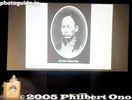
Sept. 10, 2005: My second slide show 僕のスライドショーその2I also mentioned a few important names in Japanese photography history such as Hikoma Ueno in Nagasaki who was one of Japan's first professional photographers.
日本の写真史も簡単に紹介しました。これは、上野彦馬。Oct 05, 2005
|
|

Announcement of photo contest winners フォトコンの授賞式The Kuusamo Nature Photo festival opened with the awards ceremony for the winners of the nature photo contest. Pictured here is one of the winning photos.
写真まつりの一つの事業はネイチャー写真のフォトコン。主に青年とアマ用。Oct 05, 2005
|
|

Opening ceremony 写真まつりの開会式An opening ceremony was held on September 9, 2005, the first day of the Kuusamo Nature Photo festival. Speaking is Lassi Rautiainen who headed the festival committee. Since the beginning 10 years ago, he has been the main man behind this annual nature photo festival.
実行委員長であるラッシー・ラウティアイネン氏(Lassi Rautiainen)の挨拶。この写真祭りの創業者でもある。今年で10年目。Oct 05, 2005
|
|
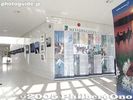
Kuusamo Hall 2nd floor lobby 2階のロビーThe balcony on the 2nd floor also served as an exhibition space and booth space for sponsors and the sale of photo books.Oct 05, 2005
|
|

Kuusamo Hall exhibition space ホール内の写真展This nice dedicated space held the BBC Wildlife Photographer of the Year exhibition.
ホール内の一番いい展示スペース。Oct 05, 2005
|
|
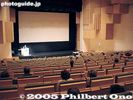
Inside Kuusamo Hall ホールの中(休憩中)The hall, called Kuusamotalo in Finnish, has a very nice auditorium with comfortable, deluxe chairs equipped with tables. As if symbolizing Finland's vast number of forests, lots of wood is also used in the hall's interior.
Opened in 1996, the hall seats over 500. It is geared for all kinds of events like conferences, concerts, stage performances, and slide shows. This is where all the slide shows were held during the Kuusamo Nature Photo festival.
We could easily project our images either with a slide projector (with remote control) or from our own laptop computer which we could control directly from the podium. The screen is very large and well-suited for slide shows. The hall's sound system is also excellent. Picture taken during a slide show break.
500人以上も入れる大ホールが木がとても奇麗。スライドショーは、自分のノートパソカンで直接上映できたり、またはホールスライド映写機でも使用できる。音響システムも抜群。Oct 05, 2005
|
|
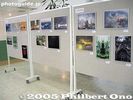
Kuusamo Hall exhibition space フォトコンの展示Photo contest winners displayed in the hall's lobby.
フォトコン受賞者の作品も展示された。Oct 05, 2005
|
|

Kuusamo Hall exhibition space ホール内の展示スペースBesides the big auditorium, Kuusamo Hall has multiple facilities including exhibition spaces and a restaurant. It functions as a performing arts and culture center.
総合的の文化施設で広い展示スペースや会議室も設けている。Oct 05, 2005
|
|
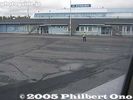
Kuusamo Airport クーサモ空港. クーサモはヘルシンキから飛行機で70分で行ける北東の自然いっぱいの町。2005年9月にクーサモのネィチャーフォトの祭りへ招待されてスライドショーをあげた。The airport is close to town, taking about 10 min. by car.
市街まで車で10分。Oct 05, 2005
|
|
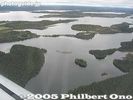
Landing in Kuusamo in northeast Finland slightly below the Arctic Circle. I was invited to their 10th Kuusamo Nature Photo festival in September 9-17, 2005 to give slide shows of Japanese photographers. クーサモの上空Lakes everywhere. In fact, about 14% of Kuusamo's land area is covered by lakes (about 166 of them), and 60% is covered by forests. Lakes and forests breed a lot of nature and wildlife. Hence, Kuusamo is one of Finland's prime areas for bird-watching and wildlife safaris. The population is over 18,000, but they receive about 1 million visitors a year for the nature and skiing.
With so much water and trees all around, I think Finland is a very pacifying country. Most people feel at peace whenever they see water or trees. Finland will probably become a popular tourist destination when more people discover it. A great place to kick back and relax.
See Kuusamo on map: Virtual Finland map
Web site: kuusamo.fi
クーサモの14%が湖で6割が森林。こんな水と木の多いところは、やはり癒してくれる環境である。言うまでもなく自然いっぱいの地域。野鳥や野生動物を観察できる最高の地域。Oct 05, 2005
|
|
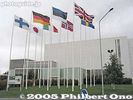
Kuusamo Hall 写真まつりのメイン会場、クーサモ・ホールKuusamo has been holding a nature photo festival annually in September since 1996 at this beautiful hall. They invite a good number of nature photographers (mostly from Europe) to give slide shows and exhibitions. The main venue is Kuusamo Hall, pictured here. They also use other venues in Kuusamo town for photo exhibitions.
Normally, the festival is held for four days centering on one weekend. But for their 10th year in 2005, the festival was held during two consecutive weekends during September 9-18. For this special year, they decided to invite people from as many countries as possible (like ten), including Japan for the first time.
In spring 2005, they contacted me for recommendations on Japanese photographers to be invited to the festival. We tried to invite a well-known Japanese photographer (with me as his guide and interpreter), but he had to pull out at the last minute so I ended up being the only person from Japan to participate in Kuusamo. I gave three slide shows held in this hall on Sept. 9, 10, and 11. Fortunately, it worked out very well.
As you can see, they raised the flags of all the countries represented at the photo festival. I was proud to see the Japanese flag and to be representing Japan even though I'm American.
Kuusamo Nature Photo Web site: kuusamo.fi/naturephoto/english.html
Kuusamo Hall Web site: kuusamo.fi/kuusamotalo/eng/
クーサモ ネイチャーフォトまつりのメイン会場であるクーサモ・ホール。この写真まつりに初めて日の丸も上がった。私はアメリカ人なのに、日本も代表できることで嬉しかった。星条旗も上げて欲しかった。クーサモ・ホールの他にも市街にある展示スペースに写真展が開催された。
今年の春にまつりの実行委員長 (Lassi Rautiainen) からメールが来て、「今年は10年目で、日本人の写真家も招待したいので推薦できる写真家がいないか」と聞かれました。私が一人の有名写真家を推薦したけど、彼が急に都合が悪くなって結局、僕一人で日本の代表として行くことになりました。これも上手くいった。Oct 05, 2005
|
|
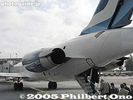
30-min. delay from Helsinki to Kuusamo... 出発30分の遅れKuusamo, the site of the annual Kuusamo Nature Photo festival I was invited to, is in northeastern Finland near the Russian border (see map). After spending a few days in Helsinki, I took this plane to Kuusamo taking about 70 min. Finnair flies from Helsinki to Kuusamo usually once a day. By car, it's about 800 km.
This day (Sept. 8, 2005), we stood in line at the gate, gave our boarding passes, and boarded a bus that would take us to the plane, a Boeing MD-82.
After standing and waiting for some minutes in the bus, they announced that they had to change one of the tires of the plane, so the flight would be delayed by 30 min. We all went back into the terminal building and waited. Of course, no one complained. We would rather fly in a safe plane. I wonder why they waited until the last minute to inspect the tires? Shouldn't they have inspected the tires the day before??
It's hard to see in this photo, but the left-most rear tire was indeed replaced. It looked new (shiny black) compared to the tire next to it.
ネイチャーフォトの写真まつりの開催地クーサモは、フィンランドの北東にある。ヘルシンキからクーサモへ毎日一便(約70分)が飛んでいるが、この日、飛行機を乗るところになんと左のタイヤの交換が必要という知らがあってターミナルビルへ戻されて30分を待った。勿論、安全が第一で誰も文句を言わなかった。この写真で見づらいが、確かに一番左のタイヤが新品だった(艶があった)。Oct 05, 2005
|
|
|
|
|